- + ACCUPLACER Mathematics
- + ACT Mathematics
- + AFOQT Mathematics
- + ALEKS Tests
- + ASVAB Mathematics
- + ATI TEAS Math Tests
- + Common Core Math
- + DAT Math Tests
- + FSA Tests
- + FTCE Math
- + GED Mathematics
- + Georgia Milestones Assessment
- + GRE Quantitative Reasoning
- + HiSET Math Exam
- + HSPT Math
- + ISEE Mathematics
- + PARCC Tests
- + Praxis Math
- + PSAT Math Tests
- + PSSA Tests
- + SAT Math Tests
- + SBAC Tests
- + SIFT Math
- + SSAT Math Tests
- + STAAR Tests
- + TABE Tests
- + TASC Math
- + TSI Mathematics
- + ACT Math Worksheets
- + Accuplacer Math Worksheets
- + AFOQT Math Worksheets
- + ALEKS Math Worksheets
- + ASVAB Math Worksheets
- + ATI TEAS 6 Math Worksheets
- + FTCE General Math Worksheets
- + GED Math Worksheets
- + 3rd Grade Mathematics Worksheets
- + 4th Grade Mathematics Worksheets
- + 5th Grade Mathematics Worksheets
- + 6th Grade Math Worksheets
- + 7th Grade Mathematics Worksheets
- + 8th Grade Mathematics Worksheets
- + 9th Grade Math Worksheets
- + HiSET Math Worksheets
- + HSPT Math Worksheets
- + ISEE Middle-Level Math Worksheets
- + PERT Math Worksheets
- + Praxis Math Worksheets
- + PSAT Math Worksheets
- + SAT Math Worksheets
- + SIFT Math Worksheets
- + SSAT Middle Level Math Worksheets
- + 7th Grade STAAR Math Worksheets
- + 8th Grade STAAR Math Worksheets
- + THEA Math Worksheets
- + TABE Math Worksheets
- + TASC Math Worksheets
- + TSI Math Worksheets
- + AFOQT Math Course
- + ALEKS Math Course
- + ASVAB Math Course
- + ATI TEAS 6 Math Course
- + CHSPE Math Course
- + FTCE General Knowledge Course
- + GED Math Course
- + HiSET Math Course
- + HSPT Math Course
- + ISEE Upper Level Math Course
- + SHSAT Math Course
- + SSAT Upper-Level Math Course
- + PERT Math Course
- + Praxis Core Math Course
- + SIFT Math Course
- + 8th Grade STAAR Math Course
- + TABE Math Course
- + TASC Math Course
- + TSI Math Course
- + Number Properties Puzzles
- + Algebra Puzzles
- + Geometry Puzzles
- + Intelligent Math Puzzles
- + Ratio, Proportion & Percentages Puzzles
- + Other Math Puzzles

How to Solve Percent Problems? (+FREE Worksheet!)
Learn how to calculate and solve percent problems using the percent formula.

Related Topics
- How to Find Percent of Increase and Decrease
- How to Find Discount, Tax, and Tip
- How to Do Percentage Calculations
- How to Solve Simple Interest Problems
Step by step guide to solve percent problems
- In each percent problem, we are looking for the base, or part or the percent.
- Use the following equations to find each missing section. Base \(= \color{black}{Part} \ ÷ \ \color{blue}{Percent}\) \(\color{ black }{Part} = \color{blue}{Percent} \ ×\) Base \(\color{blue}{Percent} = \color{ black }{Part} \ ÷\) Base
Percent Problems – Example 1:
\(2.5\) is what percent of \(20\)?
In this problem, we are looking for the percent. Use the following equation: \(\color{blue}{Percent} = \color{ black }{Part} \ ÷\) Base \(→\) Percent \(=2.5 \ ÷ \ 20=0.125=12.5\%\)
The Absolute Best Books to Ace Pre-Algebra to Algebra II
The Ultimate Algebra Bundle From Pre-Algebra to Algebra II
Percent problems – example 2:.
\(40\) is \(10\%\) of what number?
Use the following formula: Base \(= \color{ black }{Part} \ ÷ \ \color{blue}{Percent}\) \(→\) Base \(=40 \ ÷ \ 0.10=400\) \(40\) is \(10\%\) of \(400\).
Percent Problems – Example 3:
\(1.2\) is what percent of \(24\)?
In this problem, we are looking for the percent. Use the following equation: \(\color{blue}{Percent} = \color{ black }{Part} \ ÷\) Base \(→\) Percent \(=1.2÷24=0.05=5\%\)
The Best Book to Help You Ace Pre-Algebra
Pre-Algebra for Beginners The Ultimate Step by Step Guide to Preparing for the Pre-Algebra Test
Percent problems – example 4:.
\(20\) is \(5\%\) of what number?
Use the following formula: Base \(= \color{black}{Part} \ ÷ \ \color{blue}{Percent}\) \(→\) Base \(=20÷0.05=400\) \( 20\) is \(5\%\) of \(400\).
Exercises for Calculating Percent Problems
Solve each problem..
- \(51\) is \(340\%\) of what?
- \(93\%\) of what number is \(97\)?
- \(27\%\) of \(142\) is what number?
- What percent of \(125\) is \(29.3\)?
- \(60\) is what percent of \(126\)?
- \(67\) is \(67\%\) of what?
Download Percent Problems Worksheet
- \(\color{blue}{15}\)
- \(\color{blue}{104.3}\)
- \(\color{blue}{38.34}\)
- \(\color{blue}{23.44\%}\)
- \(\color{blue}{47.6\%}\)
- \(\color{blue}{100}\)
The Greatest Books for Students to Ace the Algebra
Pre-Algebra Exercise Book A Comprehensive Workbook + PreAlgebra Practice Tests
Pre-algebra in 10 days the most effective pre-algebra crash course, college algebra practice workbook the most comprehensive review of college algebra, high school algebra i a comprehensive review and step-by-step guide to mastering high school algebra 1, 10 full length clep college algebra practice tests the practice you need to ace the clep college algebra test.
by: Effortless Math Team about 4 years ago (category: Articles , Free Math Worksheets )
Effortless Math Team
Related to this article, more math articles.
- Using Strip Diagrams to Represent Fractions
- Top 10 3rd Grade NYSE Math Practice Questions
- Stretching the Line: How to Multiply Fractions by Whole Numbers with Number Lines
- How To Get A Perfect Score Of 36 On The ACT® Math Test?
- Identities of Complex Numbers
- How to Get a Perfect Score of 36 on ACT Math?
- Algebra Puzzle – Challenge 50
- FREE 8th Grade SBAC Math Practice Test
- Integral Approach to Cumulative Growth
- Top 10 Tips You MUST Know to Retake the ACT Math
What people say about "How to Solve Percent Problems? (+FREE Worksheet!) - Effortless Math: We Help Students Learn to LOVE Mathematics"?
No one replied yet.
Leave a Reply Cancel reply
You must be logged in to post a comment.
Pre-Algebra Practice Workbook The Most Comprehensive Review of Pre-Algebra
Algebra i practice workbook the most comprehensive review of algebra 1, algebra ii practice workbook the most comprehensive review of algebra 2, algebra i for beginners the ultimate step by step guide to acing algebra i, algebra ii for beginners the ultimate step by step guide to acing algebra ii, pre-algebra tutor everything you need to help achieve an excellent score.
- ATI TEAS 6 Math
- ISEE Upper Level Math
- SSAT Upper-Level Math
- Praxis Core Math
- 8th Grade STAAR Math
Limited time only!
Save Over 45 %
It was $89.99 now it is $49.99
Login and use all of our services.
Effortless Math services are waiting for you. login faster!
Register Fast!
Password will be generated automatically and sent to your email.
After registration you can change your password if you want.
- Math Worksheets
- Math Courses
- Math Topics
- Math Puzzles
- Math eBooks
- GED Math Books
- HiSET Math Books
- ACT Math Books
- ISEE Math Books
- ACCUPLACER Books
- Premium Membership
- Youtube Videos
- Google Play
- Apple Store
Effortless Math provides unofficial test prep products for a variety of tests and exams. All trademarks are property of their respective trademark owners.
- Bulk Orders
- Refund Policy
A free service from Mattecentrum
Solving problems with percentages
- Price difference I
- Price difference II
- How many students?
To solve problems with percent we use the percent proportion shown in "Proportions and percent".
$$\frac{a}{b}=\frac{x}{100}$$
$$\frac{a}{{\color{red} {b}}}\cdot {\color{red} {b}}=\frac{x}{100}\cdot b$$
$$a=\frac{x}{100}\cdot b$$
x/100 is called the rate.
$$a=r\cdot b\Rightarrow Percent=Rate\cdot Base$$
Where the base is the original value and the percentage is the new value.
47% of the students in a class of 34 students has glasses or contacts. How many students in the class have either glasses or contacts?
$$a=r\cdot b$$
$$47\%=0.47a$$
$$=0.47\cdot 34$$
$$a=15.98\approx 16$$
16 of the students wear either glasses or contacts.
We often get reports about how much something has increased or decreased as a percent of change. The percent of change tells us how much something has changed in comparison to the original number. There are two different methods that we can use to find the percent of change.
The Mathplanet school has increased its student body from 150 students to 240 from last year. How big is the increase in percent?
We begin by subtracting the smaller number (the old value) from the greater number (the new value) to find the amount of change.
$$240-150=90$$
Then we find out how many percent this change corresponds to when compared to the original number of students
$$90=r\cdot 150$$
$$\frac{90}{150}=r$$
$$0.6=r= 60\%$$
We begin by finding the ratio between the old value (the original value) and the new value
$$percent\:of\:change=\frac{new\:value}{old\:value}=\frac{240}{150}=1.6$$
As you might remember 100% = 1. Since we have a percent of change that is bigger than 1 we know that we have an increase. To find out how big of an increase we've got we subtract 1 from 1.6.
$$1.6-1=0.6$$
$$0.6=60\%$$
As you can see both methods gave us the same answer which is that the student body has increased by 60%
Video lessons
A skirt cost $35 regulary in a shop. At a sale the price of the skirtreduces with 30%. How much will the skirt cost after the discount?
Solve "54 is 25% of what number?"
- Pre-Algebra
- The mean, the median and the mode
- Stem-and-Leaf Plots and Box-and-Whiskers Plot
- Calculating the outcome
- Combinations and permutations
- Finding the odds
- Probability of events
- Geometry – fundamental statements
- Circle graphs
- Angles and parallel lines
- Quadrilaterals, polygons and transformations
- Measure areas
- Pyramids, prisms, cylinders and cones
- Square roots and real numbers
- The Pythagorean Theorem
- Trigonometry
- Algebra 1 Overview
- Algebra 2 Overview
- Geometry Overview
- SAT Overview
- ACT Overview
Percent Maths Problems
Solving Percent Problems
Learning Objective(s)
· Identify the amount, the base, and the percent in a percent problem.
· Find the unknown in a percent problem.
Introduction
Percents are a ratio of a number and 100. So they are easier to compare than fractions, as they always have the same denominator, 100. A store may have a 10% off sale. The amount saved is always the same portion or fraction of the price, but a higher price means more money is taken off. Interest rates on a saving account work in the same way. The more money you put in your account, the more money you get in interest. It’s helpful to understand how these percents are calculated.
Parts of a Percent Problem
Jeff has a coupon at the Guitar Store for 15% off any purchase of $100 or more. He wants to buy a used guitar that has a price tag of $220 on it. Jeff wonders how much money the coupon will take off the original $220 price.
Problems involving percents have any three quantities to work with: the percent , the amount , and the base .
The percent has the percent symbol (%) or the word “percent.” In the problem above, 15% is the percent off the purchase price.
The base is the whole amount. In the problem above, the whole price of the guitar is $220, which is the base.
The amount is the number that relates to the percent. It is always part of the whole. In the problem above, the amount is unknown. Since the percent is the percent off , the amount will be the amount off of the price .
You will return to this problem a bit later. The following examples show how to identify the three parts, the percent, the base, and the amount.
The previous problem states that 30 is a portion of another number. That means 30 is the amount. Note that this problem could be rewritten: 20% of what number is 30?
Solving with Equations
Percent problems can be solved by writing equations. An equation uses an equal sign (= ) to show that two mathematical expressions have the same value.
Percents are fractions, and just like fractions, when finding a percent (or fraction, or portion) of another amount, you multiply.
The percent of the base is the amount.
Percent of the Base is the Amount.
Percent · Base = Amount
Once you have an equation, you can solve it and find the unknown value. To do this, think about the relationship between multiplication and division. Look at the pairs of multiplication and division facts below, and look for a pattern in each row.
Multiplication and division are inverse operations. What one does to a number, the other “undoes.”
When you have an equation such as 20% · n = 30, you can divide 30 by 20% to find the unknown: n = 30 ÷ 20%.
You can solve this by writing the percent as a decimal or fraction and then dividing.
n = 30 ÷ 20% = 30 ÷ 0.20 = 150
You can estimate to see if the answer is reasonable. Use 10% and 20%, numbers close to 12.5%, to see if they get you close to the answer.
10% of 72 = 0.1 · 72 = 7.2
20% of 72 = 0.2 · 72 = 14.4
Notice that 9 is between 7.2 and 14.4, so 12.5% is reasonable since it is between 10% and 20%.
This problem is a little easier to estimate. 100% of 24 is 24. And 110% is a little bit more than 24. So, 26.4 is a reasonable answer.
Using Proportions to Solve Percent Problems
Let’s go back to the problem that was posed at the beginning. You can now solve this problem as shown in the following example.
You can estimate to see if the answer is reasonable. Since 15% is half way between 10% and 20%, find these numbers.
10% of 220 = 0.1 · 220 = 22
20% of 220 = 0.2 · 220 = 44
The answer, 33, is between 22 and 44. So $33 seems reasonable.
There are many other situations that involve percents. Below are just a few.
Percentages Worksheets
Welcome to the percentages math worksheet page where we are 100% committed to providing excellent math worksheets. This page includes Percentages worksheets including calculating percentages of a number, percentage rates, and original amounts and percentage increase and decrease worksheets.
As you probably know, percentages are a special kind of decimal. Most calculations involving percentages involve using the percentage in its decimal form. This is achieved by dividing the percentage amount by 100. There are many worksheets on percentages below. In the first few sections, there are worksheets involving the three main types of percentage problems: calculating the percentage value of a number, calculating the percentage rate of one number compared to another number, and calculating the original amount given the percentage value and the percentage rate.
Most Popular Percentages Worksheets this Week
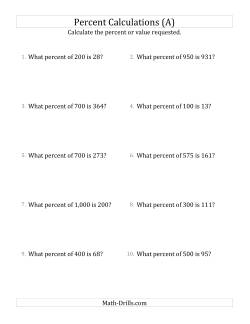
Percentage Calculations
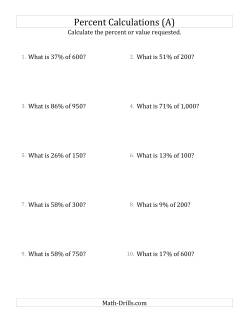
Calculating the percentage value of a number involves a little bit of multiplication. One should be familiar with decimal multiplication and decimal place value before working with percentage values. The percentage value needs to be converted to a decimal by dividing by 100. 18%, for example is 18 ÷ 100 = 0.18. When a question asks for a percentage value of a number, it is asking you to multiply the two numbers together.
Example question: What is 18% of 2800? Answer: Convert 18% to a decimal and multiply by 2800. 2800 × 0.18 = 504. 504 is 18% of 2800.
- Calculating the Percentage Value (Whole Number Results) Calculating the Percentage Value (Whole Number Results) (Percents from 1% to 99%) Calculating the Percentage Value (Whole Number Results) (Select percents) Calculating the Percentage Value (Whole Number Results) (Percents that are multiples of 5%) Calculating the Percentage Value (Whole Number Results) (Percents that are multiples of 25%)
- Calculating the Percentage Value (Decimal Number Results) Calculating the Percentage Value (Decimal Number Results) (Percents from 1% to 99%) Calculating the Percentage Value (Decimal Number Results) (Select percents) Calculating the Percentage Value (Decimal Number Results) (Percents that are multiples of 5%) Calculating the Percentage Value (Decimal Number Results) (Percents that are multiples of 25%)
- Calculating the Percentage Value (Whole Dollar Results) Calculating the Percentage Value (Whole Dollar Results) (Percents from 1% to 99%) Calculating the Percentage Value (Whole Dollar Results) (Select percents) Calculating the Percentage Value (Whole Dollar Results) (Percents that are multiples of 5%) Calculating the Percentage Value (Whole Dollar Results) (Percents that are multiples of 25%)
- Calculating the Percentage Value (Decimal Dollar Results) Calculating the Percentage Value (Decimal Dollar Results) (Percents from 1% to 99%) Calculating the Percentage Value (Decimal Dollar Results) (Select percents) Calculating the Percentage Value (Decimal Dollar Results) (Percents that are multiples of 5%) Calculating the Percentage Value (Decimal Dollar Results) (Percents that are multiples of 25%)
Calculating what percentage one number is of another number is the second common type of percentage calculation. In this case, division is required followed by converting the decimal to a percentage. If the first number is 100% of the value, the second number will also be 100% if the two numbers are equal; however, this isn't usually the case. If the second number is less than the first number, the second number is less than 100%. If the second number is greater than the first number, the second number is greater than 100%. A simple example is: What percentage of 10 is 6? Because 6 is less than 10, it must also be less than 100% of 10. To calculate, divide 6 by 10 to get 0.6; then convert 0.6 to a percentage by multiplying by 100. 0.6 × 100 = 60%. Therefore, 6 is 60% of 10.
Example question: What percentage of 3700 is 2479? First, recognize that 2479 is less than 3700, so the percentage value must also be less than 100%. Divide 2479 by 3700 and multiply by 100. 2479 ÷ 3700 × 100 = 67%.
- Calculating the Percentage a Whole Number is of Another Whole Number Calculating the Percentage a Whole Number is of Another Whole Number (Percents from 1% to 99%) Calculating the Percentage a Whole Number is of Another Whole Number (Select percents) Calculating the Percentage a Whole Number is of Another Whole Number (Percents that are multiples of 5%) Calculating the Percentage a Whole Number is of Another Whole Number (Percents that are multiples of 25%)
- Calculating the Percentage a Decimal Number is of a Whole Number Calculating the Percentage a Decimal Number is of a Whole Number (Percents from 1% to 99%) Calculating the Percentage a Decimal Number is of a Whole Number (Select percents) Calculating the Percentage a Decimal Number is of a Whole Number (Percents that are multiples of 5%) Calculating the Percentage a Decimal Number is of a Whole Number (Percents that are multiples of 25%)
- Calculating the Percentage a Whole Dollar Amount is of Another Whole Dollar Amount Calculating the Percentage a Whole Dollar Amount is of Another Whole Dollar Amount (Percents from 1% to 99%) Calculating the Percentage a Whole Dollar Amount is of Another Whole Dollar Amount (Select percents) Calculating the Percentage a Whole Dollar Amount is of Another Whole Dollar Amount (Percents that are multiples of 5%) Calculating the Percentage a Whole Dollar Amount is of Another Whole Dollar Amount (Percents that are multiples of 25%)
- Calculating the Percentage a Decimal Dollar Amount is of a Whole Dollar Amount Calculating the Percentage a Decimal Dollar Amount is of a Whole Dollar Amount (Percents from 1% to 99%) Calculating the Percentage a Decimal Dollar Amount is of a Whole Dollar Amount (Select percents) Calculating the Percentage a Decimal Dollar Amount is of a Whole Dollar Amount (Percents that are multiples of 5%) Calculating the Percentage a Decimal Dollar Amount is of a Whole Dollar Amount (Percents that are multiples of 25%)
The third type of percentage calculation involves calculating the original amount from the percentage value and the percentage. The process involved here is the reverse of calculating the percentage value of a number. To get 10% of 100, for example, multiply 100 × 0.10 = 10. To reverse this process, divide 10 by 0.10 to get 100. 10 ÷ 0.10 = 100.
Example question: 4066 is 95% of what original amount? To calculate 4066 in the first place, a number was multiplied by 0.95 to get 4066. To reverse this process, divide to get the original number. In this case, 4066 ÷ 0.95 = 4280.
- Calculating the Original Amount from a Whole Number Result and a Percentage Calculating the Original Amount (Percents from 1% to 99%) ( Whole Numbers ) Calculating the Original Amount (Select percents) ( Whole Numbers ) Calculating the Original Amount (Percents that are multiples of 5%) ( Whole Numbers ) Calculating the Original Amount (Percents that are multiples of 25%) ( Whole Numbers )
- Calculating the Original Amount from a Decimal Number Result and a Percentage Calculating the Original Amount (Percents from 1% to 99%) ( Decimals ) Calculating the Original Amount (Select percents) ( Decimals ) Calculating the Original Amount (Percents that are multiples of 5%) ( Decimals ) Calculating the Original Amount (Percents that are multiples of 25%) ( Decimals )
- Calculating the Original Amount from a Whole Dollar Result and a Percentage Calculating the Original Amount (Percents from 1% to 99%) ( Dollar Amounts and Whole Numbers ) Calculating the Original Amount (Select percents) ( Dollar Amounts and Whole Numbers ) Calculating the Original Amount (Percents that are multiples of 5%) ( Dollar Amounts and Whole Numbers ) Calculating the Original Amount (Percents that are multiples of 25%) ( Dollar Amounts and Whole Numbers )
- Calculating the Original Amount from a Decimal Dollar Result and a Percentage Calculating the Original Amount (Percents from 1% to 99%) ( Dollar Amounts and Decimals ) Calculating the Original Amount (Select percents) ( Dollar Amounts and Decimals ) Calculating the Original Amount (Percents that are multiples of 5%) ( Dollar Amounts and Decimals ) Calculating the Original Amount (Percents that are multiples of 25%) ( Dollar Amounts and Decimals )
- Mixed Percentage Calculations with Whole Number Percentage Values Mixed Percentage Calculations (Percents from 1% to 99%) ( Whole Numbers ) Mixed Percentage Calculations (Select percents) ( Whole Numbers ) Mixed Percentage Calculations (Percents that are multiples of 5%) ( Whole Numbers ) Mixed Percentage Calculations (Percents that are multiples of 25%) ( Whole Numbers )
- Mixed Percentage Calculations with Decimal Percentage Values Mixed Percentage Calculations (Percents from 1% to 99%) ( Decimals ) Mixed Percentage Calculations (Select percents) ( Decimals ) Mixed Percentage Calculations (Percents that are multiples of 5%) ( Decimals ) Mixed Percentage Calculations (Percents that are multiples of 25%) ( Decimals )
- Mixed Percentage Calculations with Whole Dollar Percentage Values Mixed Percentage Calculations (Percents from 1% to 99%) ( Dollar Amounts and Whole Numbers ) Mixed Percentage Calculations (Select percents) ( Dollar Amounts and Whole Numbers ) Mixed Percentage Calculations (Percents that are multiples of 5%) ( Dollar Amounts and Whole Numbers ) Mixed Percentage Calculations (Percents that are multiples of 25%) ( Dollar Amounts and Whole Numbers )
- Mixed Percentage Calculations with Decimal Dollar Percentage Values Mixed Percentage Calculations (Percents from 1% to 99%) ( Dollar Amounts and Decimals ) Mixed Percentage Calculations (Select percents) ( Dollar Amounts and Decimals ) Mixed Percentage Calculations (Percents that are multiples of 5%) ( Dollar Amounts and Decimals ) Mixed Percentage Calculations (Percents that are multiples of 25%) ( Dollar Amounts and Decimals )
Percentage Increase/Decrease Worksheets
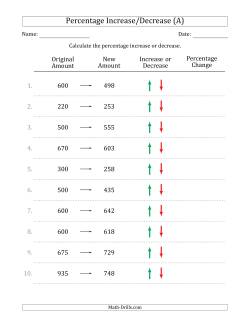
The worksheets in this section have students determine by what percentage something increases or decreases. Each question includes an original amount and a new amount. Students determine the change from the original to the new amount using a formula: ((new - original)/original) × 100 or another method. It should be straight-forward to determine if there is an increase or a decrease. In the case of a decrease, the percentage change (using the formula) will be negative.
- Percentage Increase/Decrease With Whole Number Percentage Values Percentage Increase/Decrease Whole Numbers with 1% Intervals Percentage Increase/Decrease Whole Numbers with 5% Intervals Percentage Increase/Decrease Whole Numbers with 25% Intervals
- Percentage Increase/Decrease With Decimal Number Percentage Values Percentage Increase/Decrease Decimals with 1% Intervals Percentage Increase/Decrease Decimals with 5% Intervals Percentage Increase/Decrease Decimals with 25% Intervals
- Percentage Increase/Decrease With Whole Dollar Percentage Values Percentage Increase/Decrease Whole Dollar Amounts with 1% Intervals Percentage Increase/Decrease Whole Dollar Amounts with 5% Intervals Percentage Increase/Decrease Whole Dollar Amounts with 25% Intervals
- Percentage Increase/Decrease With Decimal Dollar Percentage Values Percentage Increase/Decrease Decimal Dollar Amounts with 1% Intervals Percentage Increase/Decrease Decimal Dollar Amounts with 5% Intervals Percentage Increase/Decrease Decimal Dollar Amounts with 25% Intervals
Copyright © 2005-2024 Math-Drills.com You may use the math worksheets on this website according to our Terms of Use to help students learn math.

Solving Percent Problems
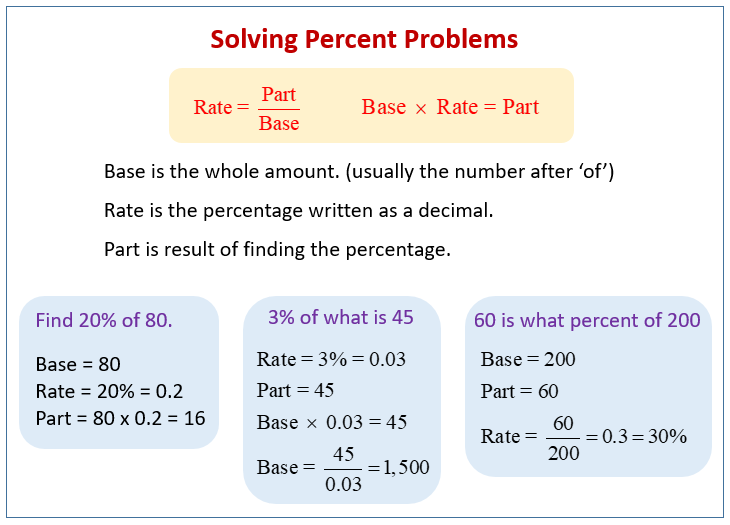

We welcome your feedback, comments and questions about this site or page. Please submit your feedback or enquiries via our Feedback page.
Solved Examples on Percentage
The solved examples on percentage will help us to understand how to solve step-by-step different types of percentage problems. Now we will apply the concept of percentage to solve various real-life examples on percentage.
Solved examples on percentage:
1. In an election, candidate A got 75% of the total valid votes. If 15% of the total votes were declared invalid and the total numbers of votes is 560000, find the number of valid vote polled in favour of candidate.
Total number of invalid votes = 15 % of 560000
= 15/100 × 560000
= 8400000/100
= 84000
Total number of valid votes 560000 – 84000 = 476000
Percentage of votes polled in favour of candidate A = 75 %
Therefore, the number of valid votes polled in favour of candidate A = 75 % of 476000
= 75/100 × 476000
= 35700000/100
2. A shopkeeper bought 600 oranges and 400 bananas. He found 15% of oranges and 8% of bananas were rotten. Find the percentage of fruits in good condition.
Total number of fruits shopkeeper bought = 600 + 400 = 1000
Number of rotten oranges = 15% of 600
= 15/100 × 600
= 9000/100
= 90
Number of rotten bananas = 8% of 400
= 8/100 × 400
= 3200/100
= 32
Therefore, total number of rotten fruits = 90 + 32 = 122
Therefore Number of fruits in good condition = 1000 - 122 = 878
Therefore Percentage of fruits in good condition = (878/1000 × 100)%
= (87800/1000)%
= 87.8%
3. Aaron had $ 2100 left after spending 30 % of the money he took for shopping. How much money did he take along with him?
Solution:
Let the money he took for shopping be m.
Money he spent = 30 % of m
= 30/100 × m
= 3/10 m
Money left with him = m – 3/10 m = (10m – 3m)/10 = 7m/10
But money left with him = $ 2100
Therefore 7m/10 = $ 2100
m = $ 2100× 10/7
m = $ 21000/7
Therefore, the money he took for shopping is $ 3000.
Fraction into Percentage
Percentage into Fraction
Percentage into Ratio
Ratio into Percentage
Percentage into Decimal
Decimal into Percentage
Percentage of the given Quantity
How much Percentage One Quantity is of Another?
Percentage of a Number
Increase Percentage
Decrease Percentage
Basic Problems on Percentage
Problems on Percentage
Real Life Problems on Percentage
Word Problems on Percentage
Application of Percentage
8th Grade Math Practice From Solved Examples on Percentage to HOME PAGE
New! Comments
Didn't find what you were looking for? Or want to know more information about Math Only Math . Use this Google Search to find what you need.
- Preschool Activities
- Kindergarten Math
- 1st Grade Math
- 2nd Grade Math
- 3rd Grade Math
- 4th Grade Math
- 5th Grade Math
- 6th Grade Math
- 7th Grade Math
- 8th Grade Math
- 9th Grade Math
- 10th Grade Math
- 11 & 12 Grade Math
- Concepts of Sets
- Probability
- Boolean Algebra
- Math Coloring Pages
- Multiplication Table
- Cool Maths Games
- Math Flash Cards
- Online Math Quiz
- Math Puzzles
- Binary System
- Math Dictionary
- Conversion Chart
- Homework Sheets
- Math Problem Ans
- Free Math Answers
- Printable Math Sheet
- Funny Math Answers
- Employment Test
- Math Patterns
- Link Partners
- Privacy Policy

Recent Articles
Time Duration |How to Calculate the Time Duration (in Hours & Minutes)
Mar 31, 24 05:49 PM
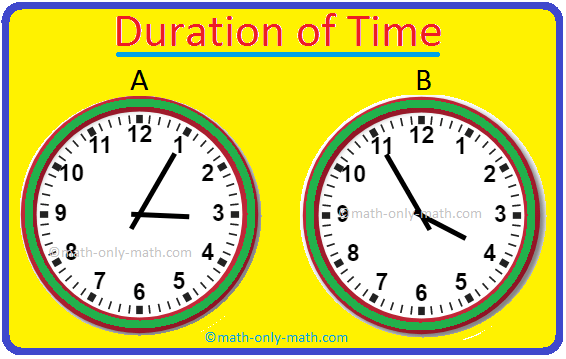
Conversion of Rupees and Paise | How to convert rupees into paise?
Mar 31, 24 05:34 PM
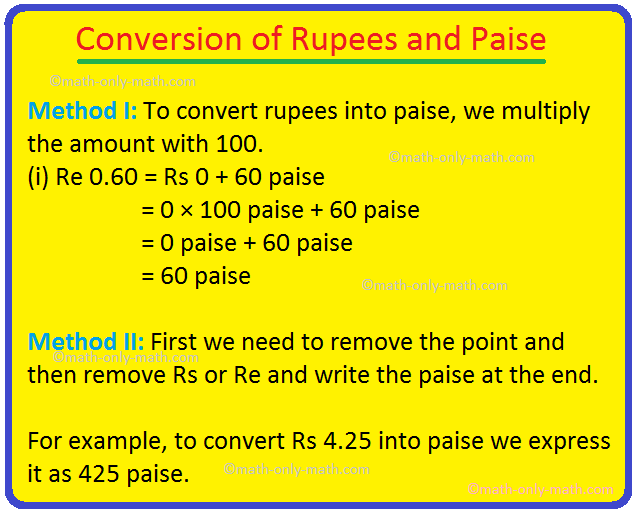
4th Grade Multiplication Worksheet | Math Multiplication Worksheets
Mar 31, 24 05:22 PM

Word Problems on Multiplication |Multiplication Word Problem Worksheet
Mar 31, 24 11:57 AM
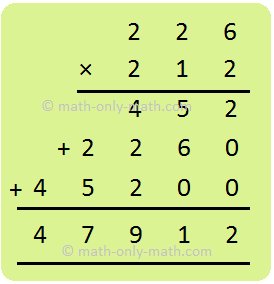
Multiplication by Ten, Hundred and Thousand |Multiply by 10, 100 &1000
Mar 31, 24 10:09 AM
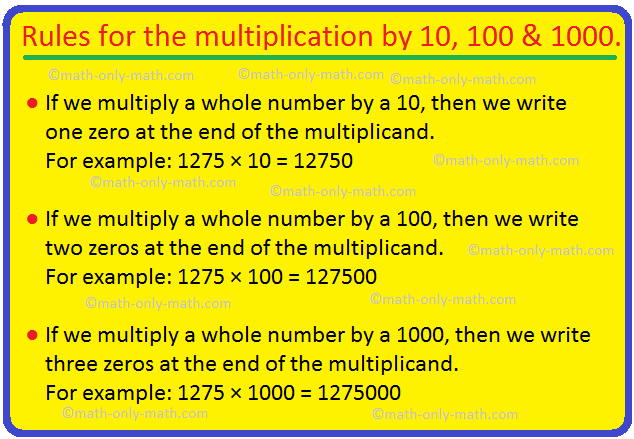
Worksheet on Fraction into Percentage
Worksheet on Percentage into Fraction
Worksheet on Percentage into Ratio
Worksheet on Ratio into Percentage
Worksheet on Percentage into Decimal
Worksheet on Percentage of a Number
Worksheet on Finding Percent
Worksheet on Finding Value of a Percentage
Worksheet on Percentage of a Given Quantity
Worksheet on Word Problems on Percentage
Worksheet on Increase Percentage
Worksheet on Decrease Percentage
Worksheet on increase and Decrease Percentage
Worksheet on Expressing Percent
Worksheet on Percent Problems
Worksheet on Finding Percentage
© and ™ math-only-math.com. All Rights Reserved. 2010 - 2024.
Solving Percent Problems
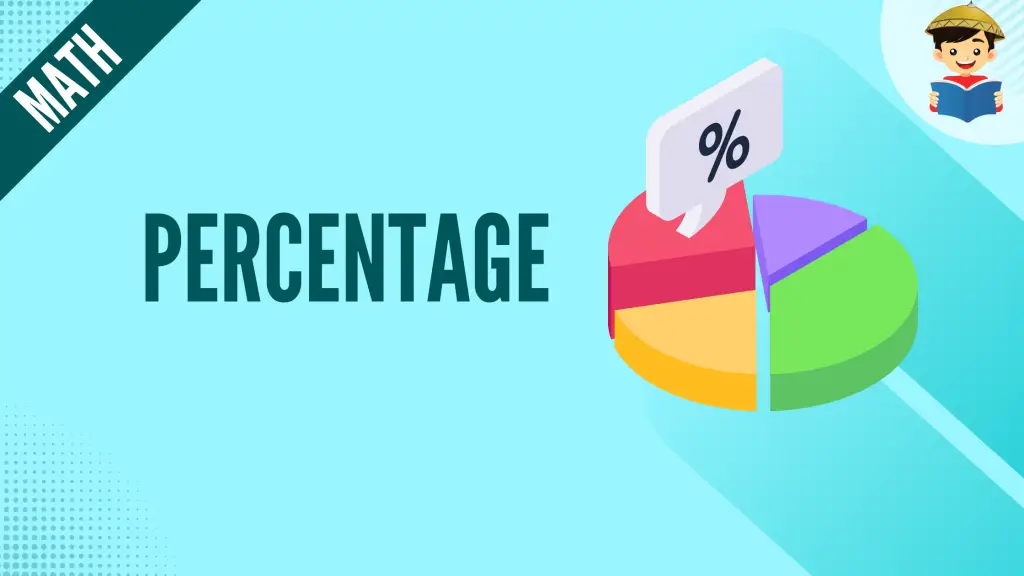
Percent is a great mathematical tool to express quantities and is used extensively in different things – from interest rates, discounts, and taxes to surveys, censuses, etc.
This article is your guide to percent and solving percent problems frequently appearing in major national examinations.
Click below to go to the main reviewers:
Ultimate UPCAT Reviewer
Ultimate NMAT Reviewer
Ultimate Civil Service Exam Reviewer
Ultimate PMA Entrance Exam Reviewer
Ultimate PNP Entrance Exam Reviewer
Ultimate LET Reviewer
Table of Contents
What does percent mean.
The word “percent” originated from the Latin phrase per centum, meaning “by hundred.” When we say “percent,” we refer to “parts per 100”. This means that a percent is a fraction with 100 as the denominator. The symbol % is used to indicate a percent.
For example, 3% means three parts per 100 or 3⁄100; 45% means 45⁄100; and 92% means 92⁄100.
Illustrating Percent
Suppose a vendor has 100 biscuits. If 10% of those biscuits are ube-flavored, 10⁄100 or 10 out of 100 biscuits are ube-flavored.
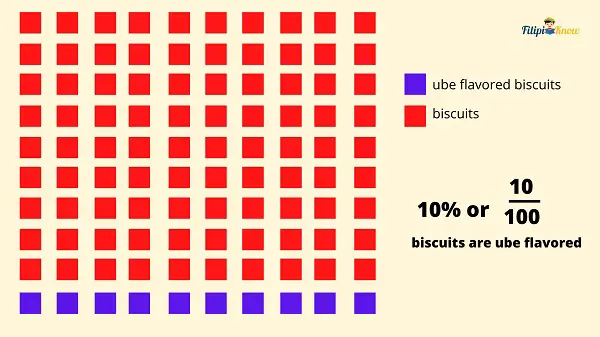
On the other hand, suppose there are 100 students in a school auditorium. If 42% of those students are honor students, 42⁄100 students, or 42 out of 100 students, are honor students.
Expressing Percent as Fraction and Decimal
Since percent means a fraction with 100 as the denominator, we can express a percent as a fraction or a decimal number .
Drop the percent sign and put 100 as the denominator to transform a percent into a fraction. For instance, 25% is simply 25⁄100.
Note that when 25⁄100 is reduced to its lowest terms, you will obtain ¼. This means that 25% is also equivalent to ¼.
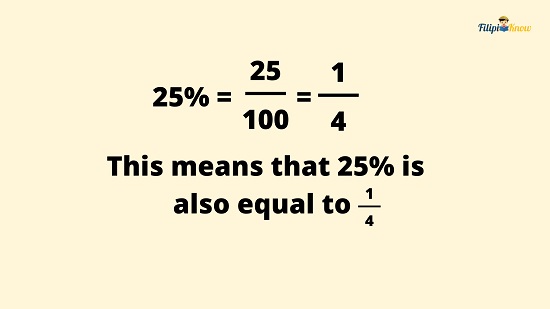
Furthermore, note that when you transform ¼ into its decimal form using the steps we have discussed in the previous reviewer , you will obtain 0.25. Hence, 25% is also equal to 0.25.
There is an easier way to transform percent into decimals . Drop the percent sign and move the decimal point two places to the left of the given number.

For example, 54% is equivalent to 0.54
Example: Transform 3% to decimal form.
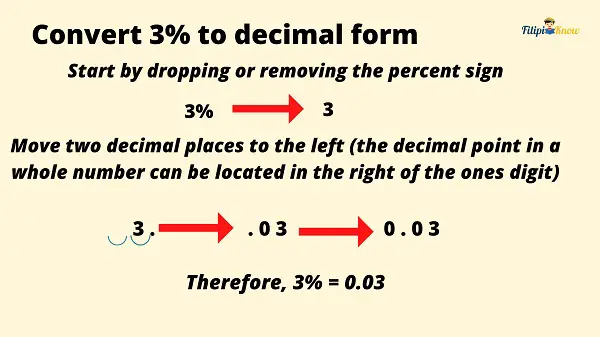
Suppose that your mom prepared ten pieces of your favorite cookies. You are excited to taste those cookies, but you realize that your brother ate 20% of the cookies that your mom prepared. What exactly is the number of cookies eaten by your brother?
To determine the answer to your question above, you must determine 20% of 10. This case involves the application of percentages.
The percentage is the result when you multiply a number by a percent. Returning to your problem about the number of cookies your brother ate, 20% of 10 can be determined if you multiply ten by 20%. The result after you multiply the numbers is called the percentage.
How To Find the Percentage
Follow these steps if you want to find the percentage:
Step 1: Convert the given percent (the one with the % sign) into decimals .
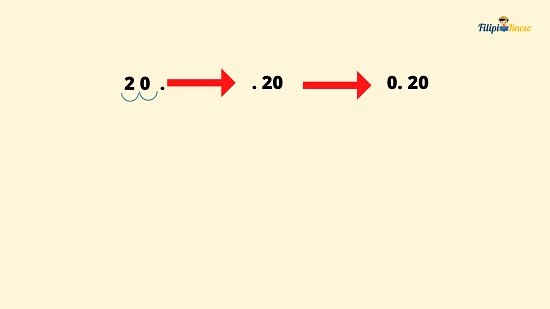
Again, to convert percent into its decimal form, we drop the percent sign and then move the decimal point two places to the left. Thus, 20% = 0.20
Step 2 : Multiply the decimal you have obtained from Step 1 to the given number. The result is the percentage.
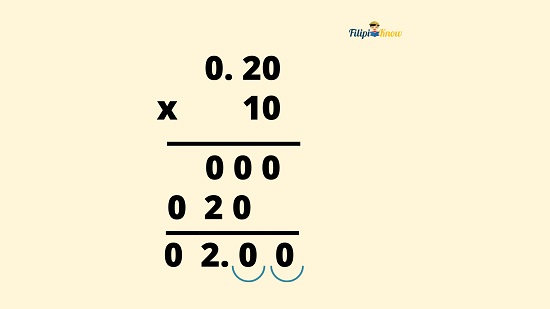
To multiply 0.20 by 10, we ignored the decimal point for a while and multiplied the given decimals like whole numbers. We have obtained 0200. Since 0.20 has two decimal places while 10 has none, the final answer should have two decimal places. We count two digits from the right of 0200 and put the decimal point there. Hence, the answer is 02.00, which is equivalent to 2.
Hence, 20% of 10 is 2. This means that out of 10 cookies your mother prepared, 2 of those were eaten by your brother.
Let us have another example.
Example: What is 50% of 120?
Step 1 : Convert the given percent (the one with the % sign) into decimals.
We drop the % sign of 50% and move the decimal point two places to the left.
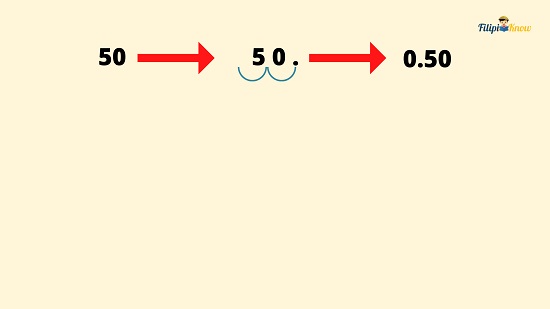
Thus, 50% = 0.50
Step 2: Multiply the decimal you have obtained from Step 1 to the given number. The result is the percentage.
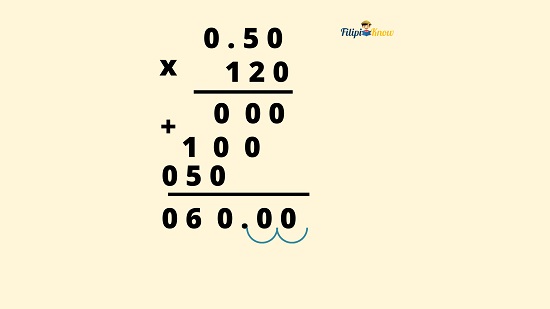
To multiply 0.50 by 120, we ignored the decimal point for a while and multiplied the given decimals like whole numbers. Through this process, we have obtained 06000. Since 0.50 has two decimal places while 120 has none, the final answer should have two decimal places. We count two digits from the right of 06000 and put the decimal point there. Hence, the answer is 060.00, which is equivalent to 60.
Hence, 50% of 120 is 60.
Simple Tricks in Computing Percentages
We always want to make our computations in mathematics faster and more accurate. For this reason, I will share two tricks you can use when computing percentages.
Trick #1: You can compute some percentages using only mental computation.
If you want to determine the 25%, 50%, 75%, or 100% of a number, you can do so without the help of pen and paper.
- 25% is equivalent to 25⁄100 or ¼. Hence, to find the 25% of a number, divide the given number by 4. Example: 25% of 40 is just 40 ÷ 4 = 10.
- 50% is equivalent to 50⁄100 or ½. Thus, to find the 50% of a number, divide the given number by 2. This means 50% of a number is just half the given number. Example: 50% of 40 is just 40 ÷ 2 = 20.
- 75% is equivalent to 75⁄100 or ¾. Thus, to find the 75% of a number, multiply the given number by three and then divide the result by 4. Example: 75% of 40 is just 40 x 3 = 120 ÷ 4 = 30.
- 100% is equivalent to 100⁄100 or 1. Thus, 100% of a number is the number itself . Example: 100% of 40 is just 40 itself.
Trick #2: X% of a number Y is equal to Y% of number X
This trick means we can transfer the % sign to the other number, and the result will be the same.
Example : What is 40% of 25?
Using trick #2, we can transfer the % sign from 40% to 25. Thus, we have 25%. This means 40% of 25 is the same as 25% of 40.
Thus, applying our first trick on finding the 25% of a number, 40 ÷ 4 = 10; hence, 40% of 25 is 10.
Example : What is 92% of 50?
92% of 50 is the same as 50% of 92. Hence, we can just divide 92 by 2 to obtain the answer, 92 ÷ 2 = 46
Therefore, 92% of 50 is 46.
Base and Rate
The base is the amount you are taking a percent of. Meanwhile, the rate is the percent you are calculating.
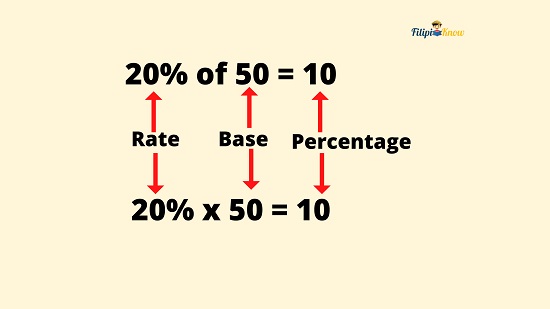
For example, if there are 50 students in a classroom and 20% of those students are honor students, it follows that ten students are honor students. 50 is the base since it is the amount we take a percent of. Meanwhile, 20% is the rate since we calculate the percentage. Lastly, 10 is the percentage.
The product of the base and the rate is the percentage .
Percentage = Base × Rate
Example: Determine the percentage, base, and rate if 20% of 90 is 18.
Since 90 x 20% = 90 x 0.20 = 18, 90 is the base, 20% is the rate, and 18 is the percentage.
Calculating Percentage, Base, and Rate
Formula to find the percentage.
The formula to find the percentage, as we have stated, is:
We can manipulate the mathematical equation above to obtain the formulas for computing the base and the rate:
Formula to Find the Base
Base = Percentage ÷ Rate
Formula to Find the Rate
Rate = Percentage ÷ Base
Example 1: If 10% of a number is 90, what is the number?
We can interpret this question as 10% of ______ = 90. Since “of” is a signal word for multiplication, it also implies 10% x ______ = 90
This means that 10% is the rate while 90 is the percentage. The unknown number is the base. Thus, we need to compute the base.
Using the formula to find the base:
Base = Percentage ÷ Rate
Base = 90 ÷ 10%
Convert the given percent into decimal:
Base = 90 ÷ 0.10
Now that you have already transformed the rate into decimal form, you may divide 90 by 0.10 to obtain the answer.
To perform division with decimal numbers , we need to transform the divisor (0.10) into a whole number by moving two decimal places to the right. Thus, the new divisor is 10. We also move two decimal places for the dividend (90). Thus, the new dividend is 9000.

We now perform long division with our new dividend and divisor:
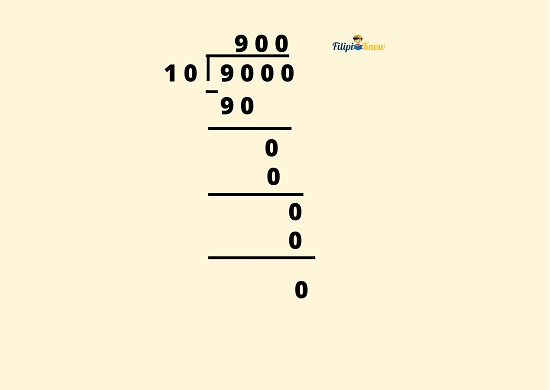
To find the base, we compute 90 ÷ 0.10 = 900
Hence, the base is 900.
Example 2: What percent of 720 is 90?
We can translate the question above in this form: _____% of 720 is 90 or _____% x 720 = 90. Therefore, 720 is the base, while 90 is the percentage. The missing number is the rate.
We will now use the formula for finding the rate.
Again, based on the given problem, the percentage is 90 while the base is 720
Rate = 90 ÷ 720
Notice that the dividend (the first number) is smaller than the divisor (the second number). In this case, you may apply the same steps in transforming fractions into decimal form because 90 ÷ 720 is a proper fraction (i.e., 90⁄720).
Let us divide 90 by 720 using the steps in transforming fractions into decimal form .
We add some zeros and decimal points to proceed with the division process.
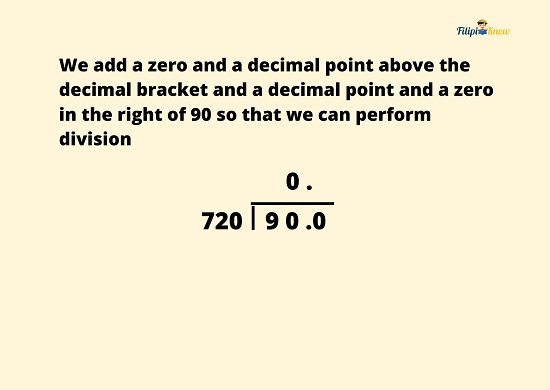
We can now divide 900 by 720.
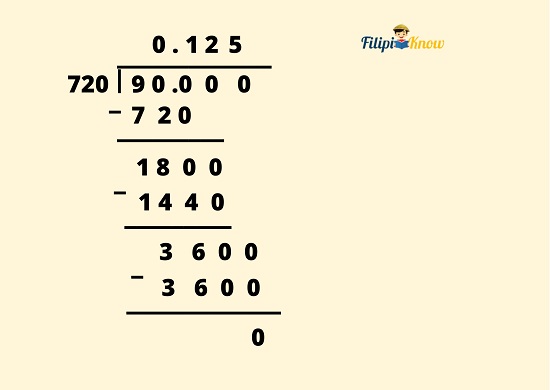
Note that every time the remainder becomes smaller than the divisor, we add zeros to 900 and the remainder to continue the division process.
The quotient we obtained is 0.125. Thus, 0.125 is our rate.
However, the rate must always be expressed with a percent sign. To do this, we multiply 0.125 by 100 or move two decimal places to the right of it and put a percent sign. Thus, 0.125 is equal to 12.5%.

Therefore, the rate is 12.5%
The Percentage, Base, and Rate Triangle
What if you forgot the formula to determine the percentage, base, or rate in a particular problem? Don’t worry because there is a fun way to derive these formulas.
Shown below is the Percentage, Base, and Rate Triangle . It is a triangle divided into three portions where P (for percentage) is written on the upper portion, and B (for base) and R (for rate) are written on the lower portions. There are also division signs in the triangle’s outer left and outer right parts and a multiplication sign below it.
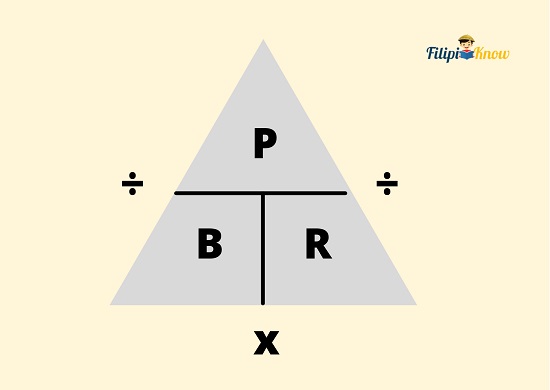
How To Use the Percentage, Base, and Rate Triangle
Suppose you are looking for the base. You have to cover the B in the triangle and look at the remaining letters and the operation between them. Notice that if you cover B, the remaining letters are P and R, with a division sign between them. This means that to find the base, you must divide P by R.

Next topic: Ratio and Proportion
Previous topic : Fundamental Operations on Fractions and Decimals
Return to the main article: The Ultimate Basic Math Reviewer
Download Printable Summary/Review Notes
Download printable flashcards, test yourself, 1. practice questions [free pdf download], 2. answer key [free pdf download], 3. math mock exam + answer key.
Written by Jewel Kyle Fabula
in Civil Service Exam , College Entrance Exam , LET , NAPOLCOM Exam , NMAT , PMA Entrance Exam , Reviewers , UPCAT
Last Updated May 3, 2023 05:59 PM
Jewel Kyle Fabula
Jewel Kyle Fabula is a Bachelor of Science in Economics student at the University of the Philippines Diliman. His passion for learning mathematics developed as he competed in some mathematics competitions during his Junior High School years. He loves cats, playing video games, and listening to music.
Browse all articles written by Jewel Kyle Fabula
Copyright Notice
All materials contained on this site are protected by the Republic of the Philippines copyright law and may not be reproduced, distributed, transmitted, displayed, published, or broadcast without the prior written permission of filipiknow.net or in the case of third party materials, the owner of that content. You may not alter or remove any trademark, copyright, or other notice from copies of the content. Be warned that we have already reported and helped terminate several websites and YouTube channels for blatantly stealing our content. If you wish to use filipiknow.net content for commercial purposes, such as for content syndication, etc., please contact us at legal(at)filipiknow(dot)net

- school Campus Bookshelves
- menu_book Bookshelves
- perm_media Learning Objects
- login Login
- how_to_reg Request Instructor Account
- hub Instructor Commons
- Download Page (PDF)
- Download Full Book (PDF)
- Periodic Table
- Physics Constants
- Scientific Calculator
- Reference & Cite
- Tools expand_more
- Readability
selected template will load here
This action is not available.

6.6: Solve Proportions and their Applications
- Last updated
- Save as PDF
- Page ID 114928

Learning Objectives
By the end of this section, you will be able to:
- Use the definition of proportion
- Solve proportions
- Solve applications using proportions
- Write percent equations as proportions
- Translate and solve percent proportions
Be Prepared 6.11
Before you get started, take this readiness quiz.
Simplify: 1 3 4 . 1 3 4 . If you missed this problem, review Example 4.44.
Be Prepared 6.12
Solve: x 4 = 20 . x 4 = 20 . If you missed this problem, review Example 4.99.
Be Prepared 6.13
Write as a rate: Sale rode his bike 24 24 miles in 2 2 hours. If you missed this problem, review Example 5.63.
Use the Definition of Proportion
In the section on Ratios and Rates we saw some ways they are used in our daily lives. When two ratios or rates are equal, the equation relating them is called a proportion .
A proportion is an equation of the form a b = c d , a b = c d , where b ≠ 0 , d ≠ 0 . b ≠ 0 , d ≠ 0 .
The proportion states two ratios or rates are equal. The proportion is read “ a “ a is to b , b , as c c is to d ”. d ”.
The equation 1 2 = 4 8 1 2 = 4 8 is a proportion because the two fractions are equal. The proportion 1 2 = 4 8 1 2 = 4 8 is read “ 1 “ 1 is to 2 2 as 4 4 is to 8 ”. 8 ”.
If we compare quantities with units, we have to be sure we are comparing them in the right order. For example, in the proportion 20 students 1 teacher = 60 students 3 teachers 20 students 1 teacher = 60 students 3 teachers we compare the number of students to the number of teachers. We put students in the numerators and teachers in the denominators.
Example 6.40
Write each sentence as a proportion:
- ⓐ 3 3 is to 7 7 as 15 15 is to 35 . 35 .
- ⓑ 5 5 hits in 8 8 at bats is the same as 30 30 hits in 48 48 at-bats.
- ⓒ $1.50 $1.50 for 6 6 ounces is equivalent to $2.25 $2.25 for 9 9 ounces.

Try It 6.79
- ⓐ 5 5 is to 9 9 as 20 20 is to 36 . 36 .
- ⓑ 7 7 hits in 11 11 at-bats is the same as 28 28 hits in 44 44 at-bats.
- ⓒ $2.50 $2.50 for 8 8 ounces is equivalent to $3.75 $3.75 for 12 12 ounces.
Try It 6.80
- ⓐ 6 6 is to 7 7 as 36 36 is to 42 . 42 .
- ⓑ 8 8 adults for 36 36 children is the same as 12 12 adults for 54 54 children.
- ⓒ $3.75 $3.75 for 6 6 ounces is equivalent to $2.50 $2.50 for 4 4 ounces.
Look at the proportions 1 2 = 4 8 1 2 = 4 8 and 2 3 = 6 9 . 2 3 = 6 9 . From our work with equivalent fractions we know these equations are true. But how do we know if an equation is a proportion with equivalent fractions if it contains fractions with larger numbers?
To determine if a proportion is true, we find the cross products of each proportion. To find the cross products, we multiply each denominator with the opposite numerator (diagonally across the equal sign). The results are called a cross product because of the cross formed. If, and only if, the given proportion is true, that is, the two sides are equal, then the cross products of a proportion will be equal.
Cross Products of a Proportion
For any proportion of the form a b = c d , a b = c d , where b ≠ 0 , d ≠ 0 , b ≠ 0 , d ≠ 0 , its cross products are equal.
Cross products can be used to test whether a proportion is true. To test whether an equation makes a proportion, we find the cross products. If they are both equal, we have a proportion.
Example 6.41
Determine whether each equation is a proportion:
- ⓐ 4 9 = 12 28 4 9 = 12 28
- ⓑ 17.5 37.5 = 7 15 17.5 37.5 = 7 15
To determine if the equation is a proportion, we find the cross products. If they are equal, the equation is a proportion.
Since the cross products are not equal, 28 · 4 ≠ 9 · 12 , 28 · 4 ≠ 9 · 12 , the equation is not a proportion.
Since the cross products are equal, 15 · 17.5 = 37.5 · 7 , 15 · 17.5 = 37.5 · 7 , the equation is a proportion.
Try It 6.81
- ⓐ 7 9 = 54 72 7 9 = 54 72
- ⓑ 24.5 45.5 = 7 13 24.5 45.5 = 7 13
Try It 6.82
- ⓐ 8 9 = 56 73 8 9 = 56 73
- ⓑ 28.5 52.5 = 8 15 28.5 52.5 = 8 15
Solve Proportions
To solve a proportion containing a variable, we remember that the proportion is an equation. All of the techniques we have used so far to solve equations still apply. In the next example, we will solve a proportion by multiplying by the Least Common Denominator (LCD) using the Multiplication Property of Equality .
Example 6.42
Solve: x 63 = 4 7 . x 63 = 4 7 .
Try It 6.83
Solve the proportion: n 84 = 11 12 . n 84 = 11 12 .
Try It 6.84
Solve the proportion: y 96 = 13 12 . y 96 = 13 12 .
When the variable is in a denominator, we’ll use the fact that the cross products of a proportion are equal to solve the proportions.
We can find the cross products of the proportion and then set them equal. Then we solve the resulting equation using our familiar techniques.
Example 6.43
Solve: 144 a = 9 4 . 144 a = 9 4 .
Notice that the variable is in the denominator, so we will solve by finding the cross products and setting them equal.
Another method to solve this would be to multiply both sides by the LCD, 4 a . 4 a . Try it and verify that you get the same solution.
Try It 6.85
Solve the proportion: 91 b = 7 5 . 91 b = 7 5 .
Try It 6.86
Solve the proportion: 39 c = 13 8 . 39 c = 13 8 .
Example 6.44
Solve: 52 91 = −4 y . 52 91 = −4 y .
Try It 6.87
Solve the proportion: 84 98 = −6 x . 84 98 = −6 x .
Try It 6.88
Solve the proportion: −7 y = 105 135 . −7 y = 105 135 .
Solve Applications Using Proportions
The strategy for solving applications that we have used earlier in this chapter, also works for proportions, since proportions are equations. When we set up the proportion , we must make sure the units are correct—the units in the numerators match and the units in the denominators match.
Example 6.45
When pediatricians prescribe acetaminophen to children, they prescribe 5 5 milliliters (ml) of acetaminophen for every 25 25 pounds of the child’s weight. If Zoe weighs 80 80 pounds, how many milliliters of acetaminophen will her doctor prescribe?
You could also solve this proportion by setting the cross products equal.
Try It 6.89
Pediatricians prescribe 5 5 milliliters (ml) of acetaminophen for every 25 25 pounds of a child’s weight. How many milliliters of acetaminophen will the doctor prescribe for Emilia, who weighs 60 60 pounds?
Try It 6.90
For every 1 1 kilogram (kg) of a child’s weight, pediatricians prescribe 15 15 milligrams (mg) of a fever reducer. If Isabella weighs 12 12 kg, how many milligrams of the fever reducer will the pediatrician prescribe?
Example 6.46
One brand of microwave popcorn has 120 120 calories per serving. A whole bag of this popcorn has 3.5 3.5 servings. How many calories are in a whole bag of this microwave popcorn?
Try It 6.91
Marissa loves the Caramel Macchiato at the coffee shop. The 16 16 oz. medium size has 240 240 calories. How many calories will she get if she drinks the large 20 20 oz. size?
Try It 6.92
Yaneli loves Starburst candies, but wants to keep her snacks to 100 100 calories. If the candies have 160 160 calories for 8 8 pieces, how many pieces can she have in her snack?
Example 6.47
Josiah went to Mexico for spring break and changed $325 $325 dollars into Mexican pesos. At that time, the exchange rate had $1 $1 U.S. is equal to 12.54 12.54 Mexican pesos. How many Mexican pesos did he get for his trip?
Try It 6.93
Yurianna is going to Europe and wants to change $800 $800 dollars into Euros. At the current exchange rate, $1 $1 US is equal to 0.738 0.738 Euro. How many Euros will she have for her trip?
Try It 6.94
Corey and Nicole are traveling to Japan and need to exchange $600 $600 into Japanese yen. If each dollar is 94.1 94.1 yen, how many yen will they get?
Write Percent Equations As Proportions
Previously, we solved percent equations by applying the properties of equality we have used to solve equations throughout this text. Some people prefer to solve percent equations by using the proportion method. The proportion method for solving percent problems involves a percent proportion. A percent proportion is an equation where a percent is equal to an equivalent ratio.
For example, 60% = 60 100 60% = 60 100 and we can simplify 60 100 = 3 5 . 60 100 = 3 5 . Since the equation 60 100 = 3 5 60 100 = 3 5 shows a percent equal to an equivalent ratio, we call it a percent proportion . Using the vocabulary we used earlier:
amount base = percent 100 amount base = percent 100
3 5 = 60 100 3 5 = 60 100
Percent Proportion
The amount is to the base as the percent is to 100 . 100 .
If we restate the problem in the words of a proportion, it may be easier to set up the proportion:
The amount is to the base as the percent is to one hundred. The amount is to the base as the percent is to one hundred.
We could also say:
The amount out of the base is the same as the percent out of one hundred. The amount out of the base is the same as the percent out of one hundred.
First we will practice translating into a percent proportion. Later, we’ll solve the proportion.
Example 6.48
Translate to a proportion. What number is 75% 75% of 90 ? 90 ?
If you look for the word "of", it may help you identify the base.
Try It 6.95
Translate to a proportion: What number is 60% 60% of 105 ? 105 ?
Try It 6.96
Translate to a proportion: What number is 40% 40% of 85 ? 85 ?
Example 6.49
Translate to a proportion. 19 19 is 25% 25% of what number?
Try It 6.97
Translate to a proportion: 36 36 is 25% 25% of what number?
Try It 6.98
Translate to a proportion: 27 27 is 36% 36% of what number?
Example 6.50
Translate to a proportion. What percent of 27 27 is 9 ? 9 ?
Try It 6.99
Translate to a proportion: What percent of 52 52 is 39 ? 39 ?
Try It 6.100
Translate to a proportion: What percent of 92 92 is 23 ? 23 ?
Translate and Solve Percent Proportions
Now that we have written percent equations as proportions, we are ready to solve the equations.
Example 6.51
Translate and solve using proportions: What number is 45% 45% of 80 ? 80 ?
Try It 6.101
Translate and solve using proportions: What number is 65% 65% of 40 ? 40 ?
Try It 6.102
Translate and solve using proportions: What number is 85% 85% of 40 ? 40 ?
In the next example, the percent is more than 100 , 100 , which is more than one whole. So the unknown number will be more than the base.
Example 6.52
Translate and solve using proportions: 125% 125% of 25 25 is what number?
Try It 6.103
Translate and solve using proportions: 125% 125% of 64 64 is what number?
Try It 6.104
Translate and solve using proportions: 175% 175% of 84 84 is what number?
Percents with decimals and money are also used in proportions.
Example 6.53
Translate and solve: 6.5% 6.5% of what number is $1.56 ? $1.56 ?
Try It 6.105
Translate and solve using proportions: 8.5% 8.5% of what number is $3.23 ? $3.23 ?
Try It 6.106
Translate and solve using proportions: 7.25% 7.25% of what number is $4.64 ? $4.64 ?
Example 6.54
Translate and solve using proportions: What percent of 72 72 is 9 ? 9 ?
Try It 6.107
Translate and solve using proportions: What percent of 72 72 is 27 ? 27 ?
Try It 6.108
Translate and solve using proportions: What percent of 92 92 is 23 ? 23 ?
Section 6.5 Exercises
Practice makes perfect.
In the following exercises, write each sentence as a proportion.
4 4 is to 15 15 as 36 36 is to 135 . 135 .
7 7 is to 9 9 as 35 35 is to 45 . 45 .
12 12 is to 5 5 as 96 96 is to 40 . 40 .
15 15 is to 8 8 as 75 75 is to 40 . 40 .
5 5 wins in 7 7 games is the same as 115 115 wins in 161 161 games.
4 4 wins in 9 9 games is the same as 36 36 wins in 81 81 games.
8 8 campers to 1 1 counselor is the same as 48 48 campers to 6 6 counselors.
6 6 campers to 1 1 counselor is the same as 48 48 campers to 8 8 counselors.
$9.36 $9.36 for 18 18 ounces is the same as $2.60 $2.60 for 5 5 ounces.
$3.92 $3.92 for 8 8 ounces is the same as $1.47 $1.47 for 3 3 ounces.
$18.04 $18.04 for 11 11 pounds is the same as $4.92 $4.92 for 3 3 pounds.
$12.42 $12.42 for 27 27 pounds is the same as $5.52 $5.52 for 12 12 pounds.
In the following exercises, determine whether each equation is a proportion.
7 15 = 56 120 7 15 = 56 120
5 12 = 45 108 5 12 = 45 108
11 6 = 21 16 11 6 = 21 16
9 4 = 39 34 9 4 = 39 34
12 18 = 4.99 7.56 12 18 = 4.99 7.56
9 16 = 2.16 3.89 9 16 = 2.16 3.89
13.5 8.5 = 31.05 19.55 13.5 8.5 = 31.05 19.55
10.1 8.4 = 3.03 2.52 10.1 8.4 = 3.03 2.52
In the following exercises, solve each proportion.
x 56 = 7 8 x 56 = 7 8
n 91 = 8 13 n 91 = 8 13
49 63 = z 9 49 63 = z 9
56 72 = y 9 56 72 = y 9
5 a = 65 117 5 a = 65 117
4 b = 64 144 4 b = 64 144
98 154 = −7 p 98 154 = −7 p
72 156 = −6 q 72 156 = −6 q
a −8 = −42 48 a −8 = −42 48
b −7 = −30 42 b −7 = −30 42
2.6 3.9 = c 3 2.6 3.9 = c 3
2.7 3.6 = d 4 2.7 3.6 = d 4
2.7 j = 0.9 0.2 2.7 j = 0.9 0.2
2.8 k = 2.1 1.5 2.8 k = 2.1 1.5
1 2 1 = m 8 1 2 1 = m 8
1 3 3 = 9 n 1 3 3 = 9 n
In the following exercises, solve the proportion problem.
Pediatricians prescribe 5 5 milliliters (ml) of acetaminophen for every 25 25 pounds of a child’s weight. How many milliliters of acetaminophen will the doctor prescribe for Jocelyn, who weighs 45 45 pounds?
Brianna, who weighs 6 6 kg, just received her shots and needs a pain killer. The pain killer is prescribed for children at 15 15 milligrams (mg) for every 1 1 kilogram (kg) of the child’s weight. How many milligrams will the doctor prescribe?
At the gym, Carol takes her pulse for 10 10 sec and counts 19 19 beats. How many beats per minute is this? Has Carol met her target heart rate of 140 140 beats per minute?
Kevin wants to keep his heart rate at 160 160 beats per minute while training. During his workout he counts 27 27 beats in 10 10 seconds. How many beats per minute is this? Has Kevin met his target heart rate?
A new energy drink advertises 106 106 calories for 8 8 ounces. How many calories are in 12 12 ounces of the drink?
One 12 12 ounce can of soda has 150 150 calories. If Josiah drinks the big 32 32 ounce size from the local mini-mart, how many calories does he get?
Karen eats 1 2 1 2 cup of oatmeal that counts for 2 2 points on her weight loss program. Her husband, Joe, can have 3 3 points of oatmeal for breakfast. How much oatmeal can he have?
An oatmeal cookie recipe calls for 1 2 1 2 cup of butter to make 4 4 dozen cookies. Hilda needs to make 10 10 dozen cookies for the bake sale. How many cups of butter will she need?
Janice is traveling to Canada and will change $250 $250 US dollars into Canadian dollars. At the current exchange rate, $1 $1 US is equal to $1.01 $1.01 Canadian. How many Canadian dollars will she get for her trip?
Todd is traveling to Mexico and needs to exchange $450 $450 into Mexican pesos. If each dollar is worth 12.29 12.29 pesos, how many pesos will he get for his trip?
Steve changed $600 $600 into 480 480 Euros. How many Euros did he receive per US dollar?
Martha changed $350 $350 US into 385 385 Australian dollars. How many Australian dollars did she receive per US dollar?
At the laundromat, Lucy changed $12.00 $12.00 into quarters. How many quarters did she get?
When she arrived at a casino, Gerty changed $20 $20 into nickels. How many nickels did she get?
Jesse’s car gets 30 30 miles per gallon of gas. If Las Vegas is 285 285 miles away, how many gallons of gas are needed to get there and then home? If gas is $3.09 $3.09 per gallon, what is the total cost of the gas for the trip?
Danny wants to drive to Phoenix to see his grandfather. Phoenix is 370 370 miles from Danny’s home and his car gets 18.5 18.5 miles per gallon. How many gallons of gas will Danny need to get to and from Phoenix? If gas is $3.19 $3.19 per gallon, what is the total cost for the gas to drive to see his grandfather?
Hugh leaves early one morning to drive from his home in Chicago to go to Mount Rushmore, 812 812 miles away. After 3 3 hours, he has gone 190 190 miles. At that rate, how long will the whole drive take?
Kelly leaves her home in Seattle to drive to Spokane, a distance of 280 280 miles. After 2 2 hours, she has gone 152 152 miles. At that rate, how long will the whole drive take?
Phil wants to fertilize his lawn. Each bag of fertilizer covers about 4,000 4,000 square feet of lawn. Phil’s lawn is approximately 13,500 13,500 square feet. How many bags of fertilizer will he have to buy?
April wants to paint the exterior of her house. One gallon of paint covers about 350 350 square feet, and the exterior of the house measures approximately 2000 2000 square feet. How many gallons of paint will she have to buy?
Write Percent Equations as Proportions
In the following exercises, translate to a proportion.
What number is 35% 35% of 250 ? 250 ?
What number is 75% 75% of 920 ? 920 ?
What number is 110% 110% of 47 ? 47 ?
What number is 150% 150% of 64 ? 64 ?
45 45 is 30% 30% of what number?
25 25 is 80% 80% of what number?
90 90 is 150% 150% of what number?
77 77 is 110% 110% of what number?
What percent of 85 85 is 17 ? 17 ?
What percent of 92 92 is 46 ? 46 ?
What percent of 260 260 is 340 ? 340 ?
What percent of 180 180 is 220 ? 220 ?
In the following exercises, translate and solve using proportions.
What number is 65% 65% of 180 ? 180 ?
What number is 55% 55% of 300 ? 300 ?
18% 18% of 92 92 is what number?
22% 22% of 74 74 is what number?
175% 175% of 26 26 is what number?
250% 250% of 61 61 is what number?
What is 300% 300% of 488 ? 488 ?
What is 500% 500% of 315 ? 315 ?
17% 17% of what number is $7.65 ? $7.65 ?
19% 19% of what number is $6.46 ? $6.46 ?
$13.53 $13.53 is 8.25% 8.25% of what number?
$18.12 $18.12 is 7.55% 7.55% of what number?
What percent of 56 56 is 14 ? 14 ?
What percent of 80 80 is 28 ? 28 ?
What percent of 96 96 is 12 ? 12 ?
What percent of 120 120 is 27 ? 27 ?
Everyday Math
Mixing a concentrate Sam bought a large bottle of concentrated cleaning solution at the warehouse store. He must mix the concentrate with water to make a solution for washing his windows. The directions tell him to mix 3 3 ounces of concentrate with 5 5 ounces of water. If he puts 12 12 ounces of concentrate in a bucket, how many ounces of water should he add? How many ounces of the solution will he have altogether?
Mixing a concentrate Travis is going to wash his car. The directions on the bottle of car wash concentrate say to mix 2 2 ounces of concentrate with 15 15 ounces of water. If Travis puts 6 6 ounces of concentrate in a bucket, how much water must he mix with the concentrate?
Writing Exercises
To solve “what number is 45% 45% of 350 ” 350 ” do you prefer to use an equation like you did in the section on Decimal Operations or a proportion like you did in this section? Explain your reason.
To solve “what percent of 125 125 is 25 ” 25 ” do you prefer to use an equation like you did in the section on Decimal Operations or a proportion like you did in this section? Explain your reason.
ⓐ After completing the exercises, use this checklist to evaluate your mastery of the objectives of this section.
ⓑ Overall, after looking at the checklist, do you think you are well-prepared for the next Chapter? Why or why not?
For more audio journalism and storytelling, download New York Times Audio , a new iOS app available for news subscribers.
Hamas Took Her, and Still Has Her Husband
The story of one family at the center of the war in gaza..
This transcript was created using speech recognition software. While it has been reviewed by human transcribers, it may contain errors. Please review the episode audio before quoting from this transcript and email [email protected] with any questions.
I can’t remember the word, but do you know the kind of fungi connection between trees in the forest? How do you call it?
Mycelium. We are just — I just somehow feel that we are connected by this kind of infinite web of mycelium. We are so bound together. And I don’t think we really realized that until all this happened.
[MUSIC PLAYING]
It’s quite hard to explain, to me in a sense, because some people would say, oh, I’m so hoping your father will come, and then everything will be OK. And it’s very hard to explain that really this group of people decided to bring us up together, shared all their resources over 75 years, grow into each other, fight endlessly with each other, love and hate each other but somehow stay together. And their children will then meet and marry and make grandchildren.
And there’s so many levels of connection. And I’m sitting here in the room, and I see their faces, some of them. And we are incredibly — it’s hard to explain how much these people are missing from our kind of forest ground. [CHUCKLES SOFTLY]
From “The New York Times,” I’m Sabrina Tavernise, and this is “The Daily.”
It’s been nearly six months since Hamas attacked Israel on October 7 and took more than 200 people into Gaza. One of the hardest hit places was a village called Nir Oz, near the border with Gaza. One quarter of its residents were either killed or taken hostage.
Yocheved Lifshitz was one of those hostages and so was her husband, Oded Lifshitz. Yocheved was eventually released. Oded was not.
Today, the story of one family at the center of the war.
It’s Friday, March 29.
OK, here we go. OK.
Good morning, Yocheved. Good morning, Sharone.
Good morning.
Yocheved, could you identify yourself for me, please? Tell me your name, your age and where you’re from.
[SPEAKING HEBREW]
OK, I’ll translate. My name is Yocheved Lifshitz. I’m 85 years old. I was born in 1938. When I was 18, I arrived at kibbutz Nir Oz. I came alone with a group of people who decided to come and form and build a community on a very sandy territory, which was close to the Gaza Strip.
And my name is Sharone Lifschitz. I am 52 years old. I was raised in kibbutz Nir Oz by my mom and dad. So I lived there until I was 20. And I live for the last 30-something years in London.
And, Sharone, what do you have next to you?
Next to me I have a poster of my dad in both English and Hebrew. And it says, “Oded Lifshitz, 83.” And below that it says, “Bring him home now.” And it’s a photo where I always feel the love because he is looking at me. And there’s a lot of love in it in his eyes.
And why did you want to bring him here today, Sharone?
Because he should be talking himself. He should be here and able to tell his story. And instead, I’m doing it on his behalf. It should have been a story of my mom and dad sitting here and telling their story.
The story of Oded and Yocheved began before they ever met in Poland in the 1930s. Anti-Semitism was surging in Europe, and their families decided to flee to Palestine — Yocheved’s in 1933, the year Hitler came to power, and Oded’s a year later. Yocheved remembers a time near the end of the war, when her father received news from back home in Poland. He was deeply religious, a cantor in a synagogue. And he gathered his family around him to share what he’d learned.
And he said, we don’t have a family anymore. They’ve all been murdered. And he explained to us why there is no God. If there was a God, he would have protected my family. And this means that there is no God.
And suddenly, we stopped going to synagogue. We used to go every Saturday.
So it was a deep crisis for him. The shock and the trauma were very deep.
Abstention.
Abstention. Soviet Union? Yes. Yes. The United Kingdom? Abstained.
Yocheved’s father lived long enough to see a state establish for his children. The UN resolution of 1947 paved the way for a new country for Jews. And the next spring, Israel declared its independence. Yocheved remembers listening to the news on the radio with her parents.
The General Assembly of the United Nations has made its decision on Palestine.
We had a country. So now we’ll have somebody who’s protecting us. It’s a country for the people, to rebuild the people. This was the feeling we had.
In other words, if God could not protect you, this nation maybe could?
Yes. But the next day, it was already sad.
Israel was immediately forced to defend itself when its Arab neighbors attacked. Israel won that war. But its victory came at a great cost to the Palestinian Arabs living there. More than 700,000 either fled or were expelled from their homes. Many became refugees in Gaza in the south.
Suddenly, Yocheved and Oded saw themselves differently from their parents, not as minorities in someone else’s country, but as pioneers in a country of their own, ready to build it and defend it. They moved to the south, near the border line with Gaza. It was there, in a kibbutz, where they met for the first time.
The first time I met him, he was 16, and I was 17. And we didn’t really have this connection happening. But when we arrived at Nir Oz, that’s where some sort of a connection started to happen. And he was younger than I am by a year and a half. So at first I thought, he’s a kid. But for some reason, he insisted. Oded really insisted. And later, turned out he was right.
What was it about him that made you fall in love with him?
He was cute.
He was a cute kid. He was a cute boy.
What’s so funny?
He was a philosopher. He wrote a lot. He worked in agriculture. He was this cute boy. He was only 20, think about it.
And then I married him. And he brought two things with him. He brought a dog and he brought a cactus. And since then we’ve been growing a huge field of cacti for over 64 years.
What did it feel like to be starting a new life together in this new country? What was the feeling of that?
We were euphoric.
And what did you think you were building together?
We thought we were building a kibbutz. We were building a family. We were having babies. That was the vision. And we were thinking that we were building a socialist state, an equal state. And at first, it was a very isolated place. There were only two houses and shacks and a lot of sand. And little by little, we turned that place into a heaven.
Building the new state meant cultivating the land. Oded plowed the fields, planting potatoes and carrots, wheat and cotton. Yocheved was in charge of the turkeys and worked in the kitchen cooking meals for the kibbutz. They believed that the best way to live was communally. So they shared everything — money, food, even child-rearing.
After long days in the fields, Oded would venture outside the kibbutz to the boundary line with Gaza and drink beer with Brazilian peacekeepers from the UN and talk with Palestinians from the villages nearby. They talked about politics and life in Arabic, a language Oded spoke fluently. These were not just idle conversations. Oded knew that for Israel to succeed, it would have to figure out how to live side by side with its Arab neighbors.
He really did not believe in black and white, that somebody is the bad guy and somebody is the good guy, but there is a humanistic values that you can live in.
Sharone, what was your father like?
My father was a tall man and a skinny man. And he was —
he is — first of all, he is — he is a man who had very strong opinion and very well formed opinion. He read extensively. He thought deeply about matters. And he studied the piano. But as he said, was never that great or fast enough for classical. But he always played the piano.
[PIANO MUSIC]
He would play a lot of Israeli songs. He wound play Russian songs. He would play French chansons.
And he had this way of just moving from one song to the next, making it into a kind of pattern. And it was — it’s really the soundtrack of our life, my father playing the piano.
[PLAYING PIANO]:
[CONVERSATION IN HEBREW]:
[PLAYING PIANO]
So one side of him was the piano. Another side was he was a peace activist. He was not somebody who just had ideals about building bridges between nations. He was always on the left side of the political map, and he actioned it.
[NON-ENGLISH CHANTING]:
I remember growing up and going very regularly, almost weekly, to demonstrations. I will go regularly with my father on Saturday night to demonstrations in Tel Aviv. I will sit on his shoulders. He will be talking to all his activist friends. The smoke will rise from the cigarettes, and I will sit up there.
But somehow, we really grew up in that fight for peace.
Yocheved and Oded’s formal fight for peace began after the Arab-Israeli war of 1967. Israel had captured new territory, including the West Bank, the Sinai Peninsula, and the Gaza Strip. That brought more than a million Palestinians under Israeli occupation.
Oded immediately began to speak against it. Israel already had its land inside borders that much of the world had agreed to. In his view, taking more was wrong. It was no longer about Jewish survival. So when Israeli authorities began quietly pushing Bedouin Arabs off their land in the Sinai Peninsula, Oded took up the cause.
He helped file a case in the Israeli courts to try to stop it. And he and Yocheved worked together to draw attention to what was going on. Yocheved was a photographer, so she took pictures showing destroyed buildings and bulldozed land. Oded then put her photographs on cardboard and drove around the country showing them to people everywhere.
They became part of a growing peace movement that was becoming a force helping shape Israeli politics. Israel eventually returned the Sinai Peninsula to Egypt in 1982.
[NON-ENGLISH SPEECH]
Whenever there is a movement towards reconciliation with our neighbors, it’s almost like your ability to live here, your life force, gets stronger. And in a way, you can think of the art of their activism as being a response to that.
And why did he and your mother take up that fight, the cause of the land? Why do you think that was what he fought for?
My father, he had a very developed sense of justice. And he always felt that had we returned those lands at that point, we could have reached long-term agreement at that point. Then we would have been in a very different space now. I know that in 2019, for example, he wrote a column, where he said that when the Palestinians of Gaza have nothing to lose, we lose big time. He believed that the way of living in this part of the world is to share the place, to reach agreement, to work with the other side towards agreements.
He was not somebody who just had ideals about building bridges between nations. Two weeks before he was taken hostage, he still drove Palestinians that are ill to reach hospital in Israel and in East Jerusalem. That was something that meant a lot to him. I think he really believed in shared humanity and in doing what you can.
Do you remember the last conversation you had with your father?
I don’t have a clear memory which one it was. It’s funny. A lot of things I forgot since. A lot of things have gone so blurred.
We actually didn’t have a last conversation. The last thing he said was, Yoche, there is a war. And he was shot in the hand, and he was taken out. And I was taken out. I couldn’t say goodbye to him. And what was done to us was done.
We’ll be right back.
Yocheved, the last thing Oded said was there’s a war. Tell me about what happened that day from the beginning.
That morning, there was very heavy shelling on Nir Oz. We could hear gunfire. And we looked outside, and Oded told me, there are a lot of terrorists outside. We didn’t even have time to get dressed. I was still wearing my nightgown. He was wearing very few clothes. I remember him trying to close the door to the safe room, but it didn’t work. He wasn’t successful in closing it.
And then five terrorists walked in. They shot him through the safe room door. He was bleeding from his arm. He said to me, Yoche, I’m injured. And then he fainted. He was dragged out on the floor. And I didn’t know if he was alive. I thought he was dead. After that, I was taken in my nightgown. I was led outside. I was placed on a small moped, and I was taken to Gaza.
And we were driving over a bumpy terrain that had been plowed. And it didn’t break my ribs, but it was very painful.
And I could see that the gate that surrounds the Gaza Strip was broken, and we were driving right through it.
And as we were heading in, I could see so many people they were yelling, “Yitbach al Yahud,” kill the Jews, slaughter the Jews. And people were hitting me with sticks. And though the drivers on the moped tried to protect me, it didn’t help.
What were you thinking at the time? What was in your mind?
I was thinking, I’m being taken; I’m being kidnapped. I didn’t know where to, but this decision I had in my head was that I’m going to take photographs in my mind and capture everything I’m seeing so that when I — or if and when I am released, I’ll have what to tell.
And when I came to a stop, we were in a village that’s near Nir Oz. It’s called Khirbet Khuza. We came in on the moped, but I was transferred into a private car from there. And I was threatened that my hand would be cut off unless I hand over my watch and my ring. And I didn’t have a choice, so I took my watch off, and I took my ring off, and I handed it to them.
Was it your wedding ring?
Yes, it was my wedding ring.
After that, they led me to a big hangar where the entrance to the tunnel was, and I started walking. And the entrance was at ground level, but as you walk, you’re walking down a slope. And you’re walking and walking about 40 meters deep underground, and the walls are damp, and the soil is damp. And at first, I was alone. I didn’t know that other people had been taken too. But then more hostages came, and we were walking together through the tunnels.
Many of whom were from kibbutz Nir Oz. These were our people. They were abducted but still alive. And we spoke quietly, and we spoke very little. But as we were walking, everybody started telling a story of what had happened to him. And that created a very painful picture.
There were appalling stories about murder. People had left behind a partner.
A friend arrived, who, about an hour or two hours before, had her husband murdered and he died in her hands.
It was a collection of broken up people brought together.
So you were piecing together the story of your community and what had happened from these snapshots of tragedies that you were looking at all around you as you were walking. What’s the photograph you’ll remember most from that day?
It would be a girl, a four-year-old girl. People kept telling her — walk, walk, walk. And we tried to calm her down. And her mom tried to carry her on her arms. It was the most difficult sight to see a child inside those tunnels.
What were you feeling at that moment, Yocheved?
Very difficult.
Where did they lead you — you and your community — from Nir Oz.
They led us to this chamber, a room, that they had prepared in advance. There were mattresses there. And that’s where we were told to sit.
I saw people sitting on the mattresses, bent down, their heads down between their hands. They were broken. But we hardly spoke. Everybody was inside their own world with themselves, closed inside his own personal shock.
Yocheved was without her glasses, her hearing aids, or even her shoes. She said she spent most days lying down on one of the mattresses that had been put out for the hostages. Sometimes her captors would let her and others walk up and down the tunnels to stretch their legs.
She said she was given a cucumber, spreading cheese, and a piece of pita bread every day to eat. They had a little bit of coffee in the morning and water all day long.
One day, a Hamas leader came to the room where she and others were being held. She said she believes it was Yahya Sinwar, the leader of Hamas, who is believed to be the architect of the October 7 attack. Two other hostages who were held with Yocheved also identified the man as Sinwar, and an Israeli military spokesman said he found the accounts reliable.
He came accompanied with a group of other men. He just made rounds between the hostages, I suppose. And he spoke in Hebrew, and he told us not to worry, and soon there’s going to be a deal and we’ll be out. And others told me, don’t speak. And I said, what is there for me to be afraid of? The worst already happened. Worst thing, I’ll be killed.
I want to say something, and I spoke my mind. I told Sinwar, why have you done what you just did to all of the same people who have always helped you? He didn’t answer me. He just turned around and they walked off.
Were you afraid to ask him why Hamas did what it did, to challenge him?
I wasn’t afraid.
I was angry about the whole situation. It was against every thought and thinking we ever had. It was against our desire to reach peace, to be attentive and help our neighbors the way we always wanted to help our neighbors. I was very angry. But he ignored what I said, and he just turned his back and walked away.
In this entire time, you had no answers about Oded?
What was the hardest day for you, the hardest moment in captivity?
It’s when I got sick. I got sick with diarrhea and vomiting for about four days. And I had no idea how this will end. It was a few very rough days. And probably because of that, they decided to free me.
They didn’t tell me they were going to release me. They just told me and another girl, come follow us. They gave us galabiya gowns to wear and scarves to wear over our heads, so maybe they’ll think that we are Arab women. And only as we were walking, and we started going through corridors and ladders and climbing up we were told that we’re going home.
I was very happy to be going out. But my heart ached so hard for those who were staying behind. I was hoping that many others would follow me.
It’s OK. Let’s go. It’s OK. Let’s go.
You go with this one.
Shalom. Shalom.
There was a video that was made of the moment you left your captors. And it seemed to show that you were shaking a hand, saying shalom to them. Do you remember doing that?
I said goodbye to him. It was a friendly man. He was a medic. So when we said goodbye, I shook his hand for peace, shalom, to goodbye.
What did you mean when you said that?
I meant for peace.
Shalom in the sense of peace.
An extraordinary moment as a freed Israeli hostage shakes hands with a Hamas terrorist who held her captive.
I literally saw my mom on CNN on my phone on the way to the airport. And it was the day before I was talking to my aunt, and she said, I just want to go to Gaza and pull them out of the earth. I just want to pull them out of the earth and take them. And it really felt like that, that she came out of the earth. And when she shook the hand of the Hamas person, it just made me smile because it was so her to see the human in that person and to acknowledge him as a human being.
I arrived in the hospital at about 5:30 AM. My mom was asleep in the bed. And she was just — my mom sleeps really peacefully. She has a really quiet way of sleeping. And I just sat there, and it was just like a miracle to have her back with us. It was just incredible because not only was she back, but it was her.
I don’t know how to explain it. But while they were away, we knew so little. We were pretty sure she didn’t survive it. The whole house burned down totally. So other homes we could see if there was blood on the walls or blood on the floor. But in my parents’ home, everything was gone — everything. And we just didn’t know anything. And out of that nothingness, came my mom back.
It was only when she got to the hospital that Yocheved learned the full story of what happened on October 7. Nir Oz had been mostly destroyed. Many of her friends had been murdered. No one knew what had happened to Oded. Yocheved believed he was dead. But there wasn’t time to grieve.
The photograph she had taken in her mind needed to be shared. Yocheved knew who was still alive in the tunnels. So she and her son called as many families as they could — the family of the kibbutz’s history teacher, of one of its nurses, of the person who ran its art gallery — to tell them that they were still alive, captive in Gaza.
And then in November came a hostage release. More than 100 people came out. The family was certain that Oded was gone. But Sharone decided to make some calls anyway. She spoke to one former neighbor then another. And finally, almost by chance, she found someone who’d seen her father. They shared a room together in Gaza before he’d gotten ill and was taken away. Sharone and her brothers went to where Yocheved was staying to tell her the news.
She just couldn’t believe it, actually. It was as if, in this great telenovela of our life, at one season, he was left unconscious on the floor. And the second season open, and he is in a little room in Gaza with another woman that we know. She couldn’t believe it.
She was very, very, very excited, also really worried. My father was a very active and strong man. And if it happened 10 years ago, I would say of course he would survive it. He would talk to them in Arabic. He will manage the situation. He would have agency. But we know he was injured. And it makes us very, very worried about the condition in which he was — he’s surviving there. And I think that the fear of how much suffering the hostages are going through really makes you unable to function at moment.
Yocheved, the government has been doing a military operation since October in Gaza. You have been fighting very hard since October to free the hostages, including Oded. I wonder how you see the government’s military operation. Is it something that harms your cause or potentially helps it?
The only thing that will bring them back are agreements. And what is happening is that there are many soldiers who have been killed, and there is an ongoing war, and the hostages are still in captivity. So it’s only by reaching an agreement that all of the hostages will be released.
Do you believe that Israel is close to reaching an agreement?
I don’t know.
You told us that after the Holocaust, your father gathered your family together to tell you that God did not save you. It was a crisis for him. I’m wondering if this experience, October 7, your captivity, challenged your faith in a similar way.
No, I don’t think it changed me. I’m still the same person with the same beliefs and opinions. But how should I say it? What the Hamas did was to ruin a certain belief in human beings. I didn’t think that one could reach that level that isn’t that much higher than a beast. But my opinion and my view of there still being peace and reaching an arrangement stayed the same.
You still believe in peace?
Why do you believe that?
Because I’m hoping that a new generation of leaders will rise, people who act in transparency, who speak the truth, people who are honest, the way Israel used to be and that we’ll return to be like we once were.
I go to many rallies and demonstrations, and I meet many people in many places. And a large part of those people still believe in reaching an arrangement in peace and for there to be no war. And I still hope that this is what we’re going to be able to have here.
Bring them home now! Bring them home now! Bring them home now! Bring them home now! Bring them home! Now! Bring them home! Now! Bring them home! Now! Bring them home!
Yocheved is now living in a retirement home in the suburbs of Tel Aviv. Five other people around her age from Nir Oz live there too. One is also a released hostage. She hasn’t been able to bring herself to go back to the kibbutz. The life she built there with Oded is gone — her photographs, his records, the piano. And the kibbutz has become something else now, a symbol instead of a home. It is now buzzing with journalists and politicians. For now, Yocheved doesn’t know if she’ll ever go back. And when Sharone asked her, she said, let’s wait for Dad.
So I’m today sitting in this assisted living, surrounded by the same company, just expecting Oded, waiting for Oded to come back. And then each and every one of us will be rebuilding his own life together and renewing it.
What are you doing to make it a home for Oded?
We have a piano. We were given a piano, a very old one with a beautiful sound. And it’s good. Oded is very sensitive to the sound. He has absolute hearing. And I’m just hoping for him to come home and start playing the piano.
Do you believe that Oded will come home?
I’d like to believe. But there’s a difference between believing and wanting. I want to believe that he’ll be back and playing music. I don’t think his opinions are going to change. He’s going to be disappointed by what happened. But I hope he’s going to hold on to the same beliefs. His music is missing from our home.
[SPEAKING HEBEW]:
[SPEAKING HEBREW] [PLAYING PIANO]
I know that my father always felt that we haven’t given peace a chance. That was his opinion. And I think it’s very hard to speak for my father because maybe he has changed. Like my mom said, she said, I hope he hasn’t changed. I haven’t changed. But the truth is we don’t know. And we don’t the story. We don’t know how the story — my father is ending or just beginning.
But I think you have to hold on to humanistic values at this point. You have to know what you don’t want. I don’t want more of this. This is hell. This is hell for everybody. So this is no, you know? And then I believe that peace is also gray, and it’s not glorious, and it’s not simple. It’s kind of a lot of hard work. You have to reconcile and give up a lot. And it’s only worth doing that for peace.
[PIANO PLAYING CONTINUES]
After weeks of negotiations, talks over another hostage release and ceasefire have reached an impasse. The sticking points include the length of the ceasefire and the identity and number of Palestinian prisoners to be exchanged for the hostages.
[BACKGROUND CONVERSATION IN HEBREW]:
Here’s what else you should know today. Sam Bankman-Fried was sentenced to 25 years in prison on Thursday, capping an extraordinary saga that upended the multi-trillion-dollar crypto industry. Bankman-Fried, the founder of the cryptocurrency exchange, FTX, was convicted of wire fraud, conspiracy, and money laundering last November.
Prosecutors accused him of stealing more than $10 billion from customers to finance political contributions, venture capital investments, and other extravagant purchases. At the sentencing, the judge pointed to testimony from Bankman-Fried’s trial, saying that his appetite for extreme risk and failure to take responsibility for his crimes amount to a quote, “risk that this man will be in a position to do something very bad in the future.”
Today’s episode was produced by Lynsea Garrison and Mooj Zaidie with help from Rikki Novetsky and Shannon Lin. It was edited by Michael Benoist, fact checked by Susan Lee, contains original music by Marion Lozano, Dan Powell, Diane Wong, Elisheba Ittoop, and Oded Lifshitz. It was engineered by Alyssa Moxley. The translation was by Gabby Sobelman. Special thanks to Menachem Rosenberg, Gershom Gorenberg, Gabby Sobelman, Yotam Shabtie, and Patrick Kingsley. Our theme music is by Jim Brunberg and Ben Landsverk of Wonderly.
That’s it for “The Daily.” I’m Sabrina Tavernise. See you on Monday.

- April 1, 2024 • 36:14 Ronna McDaniel, TV News and the Trump Problem
- March 29, 2024 • 48:42 Hamas Took Her, and Still Has Her Husband
- March 28, 2024 • 33:40 The Newest Tech Start-Up Billionaire? Donald Trump.
- March 27, 2024 • 28:06 Democrats’ Plan to Save the Republican House Speaker
- March 26, 2024 • 29:13 The United States vs. the iPhone
- March 25, 2024 • 25:59 A Terrorist Attack in Russia
- March 24, 2024 • 21:39 The Sunday Read: ‘My Goldendoodle Spent a Week at Some Luxury Dog ‘Hotels.’ I Tagged Along.’
- March 22, 2024 • 35:30 Chuck Schumer on His Campaign to Oust Israel’s Leader
- March 21, 2024 • 27:18 The Caitlin Clark Phenomenon
- March 20, 2024 • 25:58 The Bombshell Case That Will Transform the Housing Market
- March 19, 2024 • 27:29 Trump’s Plan to Take Away Biden’s Biggest Advantage
- March 18, 2024 • 23:18 Your Car May Be Spying on You
- Share full article
Hosted by Sabrina Tavernise
Produced by Lynsea Garrison and Mooj Zadie
With Rikki Novetsky and Shannon Lin
Edited by Michael Benoist
Original music by Marion Lozano , Dan Powell , Diane Wong and Elisheba Ittoop
Engineered by Alyssa Moxley
Listen and follow The Daily Apple Podcasts | Spotify | Amazon Music
Warning: this episode contains descriptions of violence.
It’s been nearly six months since the Hamas-led attacks on Israel, when militants took more than 200 hostages into Gaza.
In a village called Nir Oz, near the border, one quarter of residents were either killed or taken hostage. Yocheved Lifshitz and her husband, Oded Lifshitz, were among those taken.
Today, Yocheved and her daughter Sharone tell their story.
On today’s episode
Yocheved Lifshitz, a former hostage.
Sharone Lifschitz, daughter of Yocheved and Oded Lifshitz.

Background reading
Yocheved Lifshitz was beaten and held in tunnels built by Hamas for 17 days.
There are a lot of ways to listen to The Daily. Here’s how.
We aim to make transcripts available the next workday after an episode’s publication. You can find them at the top of the page.
Fact-checking by Susan Lee .
Additional music by Oded Lifshitz.
Translations by Gabby Sobelman .
Special thanks to Menachem Rosenberg, Gershom Gorenberg , Gabby Sobelman , Yotam Shabtie, and Patrick Kingsley .
The Daily is made by Rachel Quester, Lynsea Garrison, Clare Toeniskoetter, Paige Cowett, Michael Simon Johnson, Brad Fisher, Chris Wood, Jessica Cheung, Stella Tan, Alexandra Leigh Young, Lisa Chow, Eric Krupke, Marc Georges, Luke Vander Ploeg, M.J. Davis Lin, Dan Powell, Sydney Harper, Mike Benoist, Liz O. Baylen, Asthaa Chaturvedi, Rachelle Bonja, Diana Nguyen, Marion Lozano, Corey Schreppel, Rob Szypko, Elisheba Ittoop, Mooj Zadie, Patricia Willens, Rowan Niemisto, Jody Becker, Rikki Novetsky, John Ketchum, Nina Feldman, Will Reid, Carlos Prieto, Ben Calhoun, Susan Lee, Lexie Diao, Mary Wilson, Alex Stern, Dan Farrell, Sophia Lanman, Shannon Lin, Diane Wong, Devon Taylor, Alyssa Moxley, Summer Thomad, Olivia Natt, Daniel Ramirez and Brendan Klinkenberg.
Our theme music is by Jim Brunberg and Ben Landsverk of Wonderly. Special thanks to Sam Dolnick, Paula Szuchman, Lisa Tobin, Larissa Anderson, Julia Simon, Sofia Milan, Mahima Chablani, Elizabeth Davis-Moorer, Jeffrey Miranda, Renan Borelli, Maddy Masiello, Isabella Anderson and Nina Lassam.
Advertisement

IMAGES
VIDEO
COMMENTS
Using Proportions to Solve Percent Problems. Percent problems can also be solved by writing a proportion. A proportion is an equation that sets two ratios or fractions equal to each other. With percent problems, one of the ratios is the percent, written as \(\ \frac{n}{100}\). The other ratio is the amount to the base.
Step by step guide to solve percent problems In each percent problem, we are looking for the base, or part or the percent. Use the following equations to find each missing section.
There are three basic types of percent problems: Find a given percent of a given number. For example, find 25% of 640. Find a percent given two numbers. For example, 15 is what percent of 50? Find a number that is a given percent of another number. For example, 10% of what number is 12? Let's begin with the first of these types.
25% is part of a whole 100%.*. *25% is 1/4 of 100%*. so, you know that (150) is 1/4 of the answer (100%) Add 150 - 4 times (Because we know that 25% X 4 = 100%) And that is equal to: (150 + 150 + 150 + 150) = *600. The method they used in the video is also correct, but i think that this one is easier, and will make it more simple to solve the ...
Courses on Khan Academy are always 100% free. Start practicing—and saving your progress—now: https://www.khanacademy.org/math/cc-seventh-grade-math/cc-7th-fr...
So, to find 35% of 80, you would rewrite it as: 35% of 80 = 0.35 80. Solve the problem using decimal multiplication. Here's what the example looks like: So 35% of 80 is 28. As another example, suppose you want to find 12% of 31. Again, start by changing the percent to a decimal and the word of to a multiplication sign:
Report a problem. Do 4 problems. Learn for free about math, art, computer programming, economics, physics, chemistry, biology, medicine, finance, history, and more. Khan Academy is a nonprofit with the mission of providing a free, world-class education for anyone, anywhere.
Solving Percent Problems: Percent Increase. When a quantity changes, it is often useful to know by what percent it changed. If the price of a candy bar is increased by \(50\) cents, you might be annoyed because it's it's a relatively large percentage of the original price. If the price of a car is increased by \(50\) cents, though, you ...
Math; Pre-algebra; Unit 4: Percentages. 700 possible mastery points. Mastered. Proficient. Familiar. Attempted. Not started. Quiz. Unit test. ... Percent word problems Get 5 of 7 questions to level up! Quiz 3. Level up on the above skills and collect up to 160 Mastery points Start quiz. Up next for you:
To solve problems with percent we use the percent proportion shown in "Proportions and percent". a b = x 100 a b = x 100. a b ⋅b = x 100 ⋅ b a b ⋅ b = x 100 ⋅ b. a = x 100 ⋅ b a = x 100 ⋅ b. x/100 is called the rate. a = r ⋅ b ⇒ Percent = Rate ⋅ Base a = r ⋅ b ⇒ P e r c e n t = R a t e ⋅ B a s e. Where the base is the ...
Problem 6. A number increases from 30 to 40 and then decreases from 40 to 30. Compare the percent of increase from 30 to 40 and that of the decrease from 40 to 30. Solution to Problem 6. Percent increase from 30 to 40 is given by. (40 - 30) / 30 = 10 / 30 = 0.33 = 33% (2 significant digits) Percent decrease from 40 to 30 is given by.
Percent problems have three parts: the percent, the base (or whole), and the amount. Any of those parts may be the unknown value to be found. To solve percent problems, you can use the equation, Percent · Base = Amount, and solve for the unknown numbers. Or, you can set up the proportion, Percent = , where the percent is a ratio of a number to 100.. You can then use cross multiplication to ...
Welcome to the percentages math worksheet page where we are 100% committed to providing excellent math worksheets. ... In the first few sections, there are worksheets involving the three main types of percentage problems: calculating the percentage value of a number, calculating the percentage rate of one number compared to another number, and ...
Examples, solutions, and videos that will help GMAT students review how to solve percent word problems. The following diagram shows some examples of solving percent problems using the part, base, rate formula. Scroll down the page for more examples and solutions of solving percent problems. Solving Percent Problems. Show Step-by-step Solutions.
Now we will apply the concept of percentage to solve various real-life examples on percentage. Solved examples on percentage: 1. In an election, candidate A got 75% of the total valid votes. If 15% of the total votes were declared invalid and the total numbers of votes is 560000, find the number of valid vote polled in favour of candidate.
EXAMPLE 1: 15 is what percent of 120? To solve the problem, identify the given and unknown parts: Given: Base = 120 Unknown: Percent = x Amount = 15 Equation: 120 • x = 15 120• x 15 120 120 x 0.125 12.5% = == 0.125 120 15.000 Percent Proportion Problems involving the percent equation can also be solved with the proportion: Percent Amount (is)
Percentages (calculator) Click here for Questions. Click here for Answers. Practice Questions. Previous: Foundation Solving Quadratics. Next: Ratio Videos. The Corbettmaths Practice Questions on finding a percentage of an amount.
View more at www.MathAndScience.com. In this lesson, you will learn how to solve percent problems that you are likely to encounter in everyday situations. ...
Welcome to Finding a Percent of a Number with Mr. J! Need help with calculating percentages? You're in the right place!Whether you're just starting out, or n...
In word problems involving percentages, remember that the sum of all parts of the whole is 100 % . For example, if a teacher has graded 60 % of an assignment, then they have not graded 100 − 60 % = 40 % of the assignment. 60 % and 40 % are complementary percentages: they add up to 100 % .
Percent is a great mathematical tool to express quantities and is used extensively in different things - from interest rates, discounts, and taxes to surveys, censuses, etc.. This article is your guide to percent and solving percent problems frequently appearing in major national examinations.
Divide: 15/50 = 0.30. 15 = 50 x Original equation. 15 50 = 50 x 50 Divide both sides by 50. 15 50 = x Simplify right-hand side. x = 0.30 Divide: 15/50 = 0.30. But we must express our answer as a percent. To do this, move the decimal two places to the right and append a percent symbol. Thus, 15 is 30% of 50.
Regulators, airlines, fliers and even Boeing's own workers are practically in revolt after a series of mid-flight disasters and a steady erosion of the company's quality standards. Investors ...
The proportion method for solving percent problems involves a percent proportion. A percent proportion is an equation where a percent is equal to an equivalent ratio. For example, 60% = 60 100 60% = 60 100 and we can simplify 60 100 = 3 5. 60 100 = 3 5.
Hamas Took Her, and Still Has Her Husband. The story of one family at the center of the war in Gaza. March 29, 2024. Share full article. 6. Hosted by Sabrina Tavernise. Produced by Lynsea Garrison ...